Feed aggregator
Wait, Is It Hughday Again?
Is it a serial? No. It’s going slow, and we are having to backtrack, so it is probably not suitable for serialization. However, people are really stressed. We are seeing an uptick in “My emotions are frayed right now, and the snippets are helping” messages.
The political ban is still in effect, so Mod R will be removing comments that mention politics. We are committed to keeping this blog a place where everyone can come to decompress, especially because spaces like these are in short supply right now. However, I wanted to address some of these emails. We see you, we understand that life is hard and you are struggling and stressed, and we are so sorry.
When the pandemic started, the economists warned that recovery would take 15 years. You can’t just hit pause on the world for months and not pay the price later. We did it to survive, but now we have to collectively try to claw our way back out of the pit it created. This is a very difficult process. It’s slow and painful, it affects every aspect of our life, and it makes everything so much harder.
I’m with you. I’m creatively discouraged and stressed. We’re going to take a financial hit later in the year due to unforeseen circumstances, and I’m not wild about that. One of my children is choosing to return to college to get her degree, because the opportunities she had previously evaporated. Gordon will likely need surgery. It’s easier to say what isn’t wrong with his shoulder – it’s not broken. I was on the phone for 2 hours trying to get a referral put through and I know my nerves are frayed, because I had to take a few minutes after that.
However, we are all going to keep going, because rolling over and giving up is not an option. So, for the foreseeable future, we are going to have something fun here on Friday. Something that will give you a break from the constant stress and daily grind. For now, it’s Hughday. Some Fridays, it might be something else.
If you have any fun ideas for quizzes, giveaways, or articles, please leave us a comment.
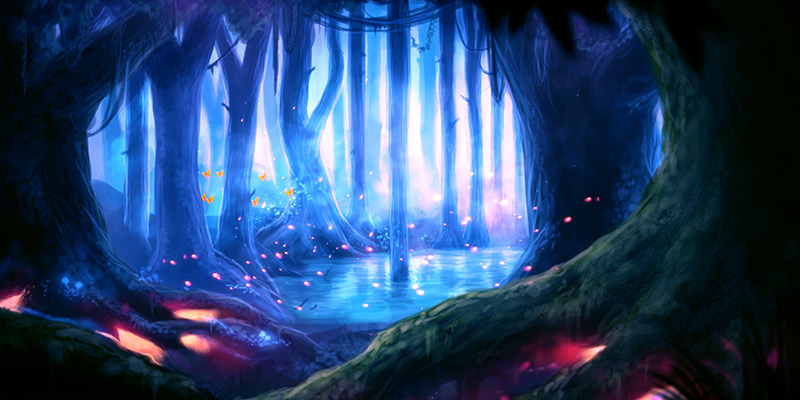 Chapter 1 Part 2
Chapter 1 Part 2
The depression gouged the forest floor, about forty feet long, twenty-five feet wide, and two feet deep. It was less of a pit and more of a hollow, vaguely rectangular, but without the defined corners or sheer walls that would point at a human with a shovel being involved. The edges of the hollow sloped slightly, as if some giant pressed their palm into the forest floor, and the ground at its bottom was bare and soft like a plowed field.
Hugh crouched on the edge and frowned. Around the shallow pit, a dozen Iron Dogs waited, holding their torches over it. The flickering lights played on bare bones arranged in the dirt. A lot of bones. He recognized femurs from at least two horses, wings from what might have been a griffon, and paws from a bear. A freakishly large bear, too.
The bones had been carefully arranged into a pattern. Here and there, the different femurs, radiuses, ribs, and vertebrae were bound together by copper wire and twine with little bone beads. This wasn’t a mass grave. This was something else. Something malignant, with a specific purpose.
He passed his hand over it, just in case. Nothing. With tech up, the bones were inert.
Hugh looked up, past the hollow, at the massive tree rising behind it, soaked in night shadows. An Iron Dog had thrust a torch into the ground by its roots and the glow of the fire illuminated a fragment of twine hanging from the bark, its end frayed. Someone had wrapped the same twine that secured the bones around the giant trunk and then sliced through it and ripped it off.
Must’ve been in a hurry.
He rose and glanced at Sharif, waiting on his left. The dark-haired scout master met his gaze. Yellow fire rolled over his irises.
“How old is the site?”
“Three days.”
The end of the most recent magic wave.
“Any scents?”
Sharif grimaced. “Wolfsbane.”
Damn. The sense of smell was the most acute and accurate of a werewolf’s senses. They memorized thousands of human scents. Normally Sharif would’ve identified the gender, possibly the age, sometimes even a chronic illness, and if he’d met them before, a name. Wolfsbane nullified all of that. It rendered shapeshifters nose-blind, and it stuck around for days after the other scent trails faded.
“Nothing useful at all?” Hugh asked.
“Their wolfsbane is very potent, so there is that.”
And the best producer of potent wolfsbane was a mile to the south, watching baking shows in her turret.
“Could it be someone from Baile?”
Sharif shrugged. “It could be. We followed the wolfsbane to a clearing a hundred yards to the north. It ended there.”
“What do you mean, it ended?”
“The trail stopped.”
“So the magic user disappeared in the middle of our woods?”
“I cannot say. The trail ended.”
Teleportation was possible, but it was inherently rare and extremely risky, and the magic was down. Yet another thing that didn’t make sense.
“So we have a magic user,” Hugh said. “The wave caught them mid-whatever this is. Something alarmed them, and they took off, leaving all their toys behind, and then disappeared a hundred yards north.”
“It was Tatter,” Sharif said. “That’s how Karen found this in the first place. She was following the pack, trying to map their hunting patterns.”
Tatter and Gold were the dominant breeding pair of a local dire wolf pack, and they were a massive pain in the ass. Tatter, a huge male with a torn right ear, clocked in at two hundred pounds. His mate was only slightly smaller, and she made up for it with viciousness and cunning. They led about sixteen wolves, making circles around the castle and the adjacent village by the lake. They were smart and patient, sending out strike teams to bring prey back, while the aging generation watched the pups. The livestock herders were having the devil of a time keeping them away. If it hadn’t been for the guard dogs, Baile’s herd would be half of what it was in early fall. He had had to heal two of the hounds just last week.
With magic down, whoever put this bone mandala together would have no chance against Tatter and his hunting pack. That explained why the magic user split. It didn’t explain what they were doing here or why.
“Tatter left a mark on a tree about ten yards out,” Sharif reported.
Didn’t touch the bones though.
“Is this some kind of witch ritual?” Stoyan murmured.
Baile was home to seven different covens. It was a good guess, but this bone arrangement gave off a different vibe.
Hugh nodded to the huge tree. “That’s an oak.”
Stoyan squinted at it. “Druids?”
“Probably.”
Pre-Shift Druidism was a folkloric speculation. A prevalent religion among ancient Celts and Gauls, Druidism relied on oral tradition, lost to time. What little was known about it came mostly from Roman records, written by biased invaders determined to conquer new territory. Historic druids revered trees, especially the oak, treated and induced diseases, composed poetry, and foretold the future by means of augury and sacrifice. That sacrifice wasn’t always chickens and rabbits. Sometimes they needed a little more juice.
Post-Shift, when magic became real, druidism, like other neo-pagan religions, returned with a vengeance. The modern practitioners patchworked it together from Julius Caesar’s journals, Taliesin’s poems, new age mysticism, and wishful thinking. Over the decades, the neo-druids codified their rites and holidays and set forth some fundamental philosophical tenets, but beyond that, the consensus on how to be a druid was rather shaky. Some of them waded neck-deep into the kind of evil shit that would get them exterminated if the public at large knew about it. He’d come across that kind of druidism before, and the experience was never pleasant. The dusk druids packed a lot of power.
There were druids in Baile Castle, and their leader, Dugas, was one of Elara’s closest allies. She treated him like a surrogate father. On a scale from 1 to 10, when it came to dangerous opponents, Dugas was around 12. During the battle of Aberdine, the druid had stuck to support spells and then used his staff as a club–except for one time, when he was cornered by three armored soldiers and didn’t think anyone was looking. Hugh saw him tap his staff on the ground and then the three men in front of him vomited tree roots and died.
Dugas took care to appear less dangerous than he was. Hugh had no idea whether the man was a dusk druid, but if that was true, he wouldn’t be surprised. He had never seen him sacrifice anything; however, Stoyan and Lamar, his other centurion, had. Or almost had. Elara chased them off before the actual act, but the night she came to get him, they saw a line of cows painted in glyphs and Dugas with a knife.
He glanced at Stoyan. The centurion leaned closer.
“When you saw Dugas with the cows, what was he wearing?”
“A white robe.”
“You sure?”
“Yes.”
Druids wore special robes for sacrificial rites. They were blood red. It could’ve meant something or nothing.
He didn’t know how territorial Dugas was, either. The overwhelming majority of druids felt that the way other druids used their magic was none of their business. If they knew that one of them was doing terrible shit, they wouldn’t prevent it, as long as it didn’t directly affect them.
This ritual site was about a mile from the castle. Too close for any kind of comfort. Either this was done by an outsider, who didn’t fear Dugas or was confident he wouldn’t care; or it was done by Dugas himself or with his blessing. Either way, whoever had done it didn’t want to be identified, otherwise there was no point in using wolfsbane.
If this was Dugas’s handiwork, he was trying to hide it.
It could be part of the darker side of Elara’s magic. Dugas could be doing something with her blessing and instruction to keep it from them.
Hugh still had no idea what she was. Her people called themselves the Departed – again, he didn’t know why – and most of the time they were friendly and straight-forward, going about their lives. But then he had seen a time when they acted together as one, their magic united into a frightening whole, and that power had an ancient bite. The older the magic, the more power.
Hugh studied the bones again. If there was a choice between him and Dugas, he had no doubt Elara would choose the druid.
He could investigate it quietly, using just his Iron Dogs, or he could take it to Elara. If he took it to Elara, and this was something of hers that she wanted to protect, he would be putting his people at risk. But if it wasn’t and later she asked him why he found weird shit in the woods and didn’t tell her, he would have to admit it was because he didn’t trust her.
That would be the end, he realized. They would not come back from that.
She came to get him. She faced Roland for him.
Fuck it.
“Take the Polaroids,” Hugh ordered. “Sketch it, photograph it, and guard it. Nobody touches it while I’m gone.”
The Iron Dogs snapped to attention. “Yes, Preceptor.”
The post Wait, Is It Hughday Again? first appeared on ILONA ANDREWS.
Lowering the Hammer Snippet 3
Normal 0 false false false EN-US X-NONE X-NONE MicrosoftInternetExplorer4 /* Style Definitions */ table.MsoNormalTable {mso-style-name:"Table Normal"; mso-tstyle-rowband-size:0; mso-tstyle-colband-size:0; mso-style-noshow:yes; mso-style-priority:99; mso-style-qformat:yes; mso-style-parent:""; mso-padding-alt:0in 5.4pt 0in 5.4pt; mso-para-margin:0in; mso-para-margin-bottom:.0001pt; mso-pagination:widow-orphan; font-size:10.0pt; font-family:"Times New Roman","serif";}
Chapter 3
Tortuga, Omicron sector
The being known as the Wraith Queen reached out through her communication centers in the vast ship and tested them. She worked out new protocols to control the ships around her. But she knew she was lacking in abilities. She resented having to rely on the alliance. It ran against her core programming in some ways. Not all ways thankfully, as her organic partner had pointed out; their creators had left room for them to use and exploit other beings in accordance with completing their mission.
She was still looking forward to the day that she could renounce the partnership in fire and end the Necrons once and for all.
Until then she had to rely on them to fill the gaps in her abilities.
At least, for the time being.
<<V>>
Edessa
One of the cruisers dispatched south to hold the border to Pi sector returned to the nearest ansible location with news that two ships had been stopped but one other had been spotted but was now missing. The leadership of the Necrons was concerned. They passed the news on to their partners in Tortuga as they went over the data.
<<V>>
Tortuga
Hazel Irons was not surprised that her Queen reacted badly to the news when it came in through the ansible. The AI was not happy at all with the events and seethed about it. Hazel did her best to try to soothe her.
She was one of the oldest clone changelings in existence. Her line had been so reliable; it had been used until it had become too recognizable by the enemy. In fact, to date they had not found any other changelings.
By luck or circumstance, the changeling and her AI partner had been dumped into a stasis pod and left adrift in Pi sector. They had been found and salvaged by pirates who had been fleeing the growing Federation presence in the area. The duo had accidentally been awoken, and they had decided to first take over the ship and then move on from there.
It was an interesting partnership. Hazel had no illusions as to who was the dominant of them. She was a kingmaker, the power behind the throne, the voice of sweet reason and the spark of creativity that her partner lacked.
She also knew she was ultimately disposable. She believed she was still of use for her partner and the cause though, so she did her best to remain useful.
Her partner had grown to the point where she had been forced out and into a new body in the form of the massive flagship under construction. However delays had kept the ship in dock and hampered by problems that plagued their ability to fully function as planned for some time. It did not help the AI’s mood at all.
“If the ship did escape, and we don’t know if it did, it would have to survive the jump back to Pi sector, which is over a year. It has an unknown amount of supplies available and fuel,” Hazel mused.
“I see what you are doing. You are trying to convince me that the risk of exposure is small. Small enough to be ignored,” the Wraith seethed.
“No, I am working the problem by defining the variables in it,” her clone partner explained gently. It hurt to argue with her partner. They were made to work together after all. They were an incredible team, just look at what they had achieved so far! Other changelings would have doggedly stuck to their mission or given up! They had instead taken over a ship and then others and then forged an unlikely alliance with Necrons to take over the sector!
They still had some work to do but their progress was breathtaking. And it was happening faster than either of them expected. Well, faster than she had expected.
“I cannot in good conscience state that the risk is negligible given that the missing ship is a Federation ship,” Hazel said slowly.
“And?”
“I believe that means we have to generate some plans and modify existing ones,” the clone stated slowly.
“Such as?” the Wraith prompted. Her clone and former host was the spark of ingenuity in their partnership. She was cunning and clever to a degree, but the human was the true mastermind of some of their achievements.
“Two paths are obvious to me,” the clone said as she came up with the plan. “First, we send a task force to defend the jump line in Pi with an ansible link to keep us alerted to any further events there.”
“A bit late,” the Wraith said scathingly.
“Only in attempting to stop the single ship. There may be others,” her human partner warned.
“Agreed,” the AI hissed.
“And there may be new traffic coming from Pi. In fact, that is inevitable given how the Federation is expanding. Eventually they will send ships, if only to find out what happened to the first explorers they sent.”
“Agreed,” the AI stated. “What else?”
“I suggest we send a small task force, possibly just a couple of cruisers to Pi to run the fleeing ship down. If they can get ahead of the ship, they can lay in wait and ambush the ship and thus prevent it from reporting back. At the least, they could report on events in Pi sector and possibly even interdict shipping in that sector before it even comes to us.”
The Wraith queen took some time to respond. Hazel glanced around and then checked the status board of the star system in a bid to keep busy.
“You would want to send an ansible there too I suppose?” the AI finally asked after running a number of simulations. “The risk of exposure is high.”
“It is if they enter a star system. If they remain outside it as observers, it is less of a risk. If they engage, yes, the risks grow.”
“Especially if the ship escapes them further.”
“Correct. But if we do nothing, that risk is there anyway. Attempting to stop them may correct the problem.”
“Or make it worse,” the Wraith replied. “But I see your point.” The AI paused. “I will give the order.”
“Good.”
<<V>>
Teacup special effects by KNB EFX
While Teacup—the Peacock series very loosely-based on Robert McCammon’s Stinger—has already been cancelled after just one season, one aspect of the show that was done well is the special effects work by KNB EFX. Given that the ‘N’ in KNB EFX is Greg Nicotero, who is co-producing the upcoming Swan Song series, it’s a safe bet that KNB EFX will also be doing the effects for that show.
On December 30, 2024, the website Animation World Network published an article about the effects in Teacup, complete with a bunch of photos showing the concepts and how the effects were done.
Carey Jones Serves Up a Macabre Special Effects Brew for ‘Teacup’
Also, as Hollywood is wont to do these days, just six days after the first two episodes of Teacup were released, Peacock released this spoiler-filled video about the special effects for the show.
The Teller of Small Fortunes - Book Review
 The Teller of Small Fortunesby Julie Leong
The Teller of Small Fortunesby Julie LeongWhat is it about:Tao is an immigrant fortune teller, traveling between villages with just her trusty mule for company. She only tells "small" fortunes: whether it will hail next week; which boy the barmaid will kiss; when the cow will calve. She knows from bitter experience that big fortunes come with big consequences…
Even if it’s a lonely life, it’s better than the one she left behind. But a small fortune unexpectedly becomes something more when a (semi) reformed thief and an ex-mercenary recruit her into their desperate search for a lost child. Soon, they’re joined by a baker with a knead for adventure, and—of course—a slightly magical cat.
Tao sets down a new path with companions as big-hearted as her fortunes are small. But as she lowers her walls, the shadows of her past are closing in—and she’ll have to decide whether to risk everything to preserve the family she never thought she could have.
What did I think of it:This is such a good read!
I will confess I fell in love with the cover, and that's why I bought tis book. It turned out to be a Cozy Fantasy: as if your read is giving you a hug by being mostly nice, comforting, and happy.
I loved Tao and the people she meets and befriends. Especially Mash, the ex-mercenary is so awesome (and bearded mostly, although he should stop shaving entirely Voodoo Bride wants me to add).
There are of course some stakes to keep everyone moving, but I never worried, trusting that this book wouldn't disappoint me by suddenly being mean to me.
All in all a wonderful read, and I immediately bought an extra copy to gift a good friend for her birthday (because nobody gets to borrow mine!).
Why should you read it:Cozy Fantasy! So nice and huggable!
Goth Chick News: The Hairy Problem of Werewolf Movies
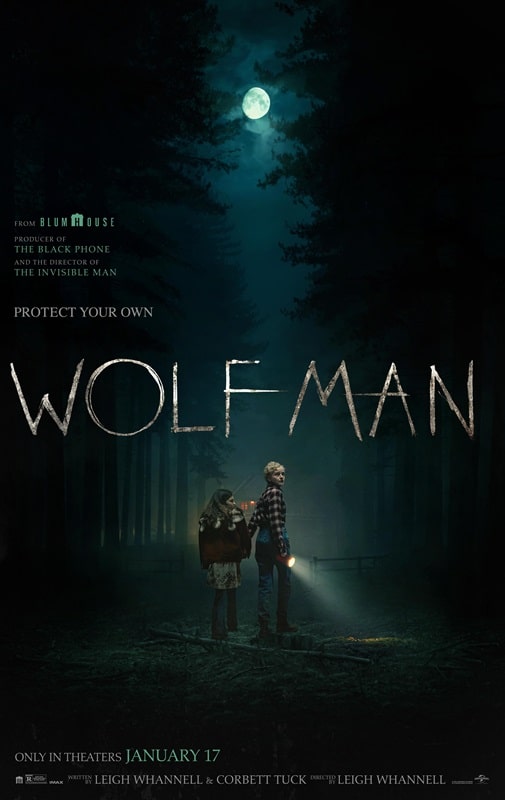 Wolf Man (Universal Pictures, January 17, 2025)
Wolf Man (Universal Pictures, January 17, 2025)
Why oh why can’t Hollywood produce a decent werewolf movie?
I’ve had my heart broken twice in the past few months, first by The Beast Within (2024) and most recently by Wolf Man (2025).
I first told you about The Beast Within starring Kit Harington, back in August. In summary, it was lousy. Though the trailer implied a suspenseful, cohesive tale, Beast was a rambling affair that didn’t seem to know what it wanted to be. As for an actual werewolf transformation, it was implied but never really materialized. Instead, director Alexander J. Farrell tried to distract us from this fact with a knee-jerking series of events that barely held together as a story. Even putting Harington half-naked in a dog collar wasn’t enough to make me forgive this mess.
So, if you tell me I should have known better when, with renewed hope, I ran off to the theater last weekend to see Wolf Man, I wouldn’t argue.
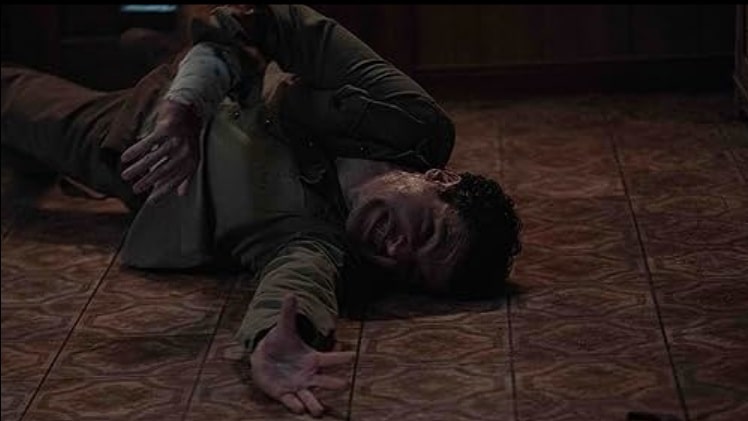 Wolf Man
Wolf Man
Making another attempt at revitalizing the classic monsters franchise ahead of opening its “Dark Universe” park in May, Universal Studios got behind this werewolf movie produced by Blumhouse, which made me think there was a chance it would be good. Afterall, it was Jason Blum who inspired Universal to give their Dark Universe movie franchise another go after Tom Cruise’s The Mummy was an unmitigated atrocity.
Universal had scrapped all the big-budget monster remakes they had teed up, which was more than fine with most fans, including me. Then here comes indie production company Blumhouse, hitting a home run with The Invisible Man (2020). Making nearly $145M on a $7M budget that’s a 20x return, meaning Hollywood couldn’t throw new projects at Jason Blum fast enough. When I heard Blumhouse had been handed the remake of Wolf Man (1941) I dared to be cautiously optimistic.
What a mistake.
I can count on one hand the number of times I’ve sat in a theater looking at my watch. I nearly always find something to love about most movies, but Wolf Man was so awful I would have got up and left had it not been for the tiny flame of hope I had that maybe the ending would redeem my two-hour investment.
It didn’t.
Here’s how Universal described Wolf Man:
Golden Globe nominee Christopher Abbott (Poor Things, It Comes at Night) stars as Blake, a San Francisco husband and father, who inherits his remote childhood home in rural Oregon after his own father vanishes and is presumed dead. With his marriage to his high-powered wife, Charlotte (Emmy winner Julia Garner; Ozark, Inventing Anna), fraying, Blake persuades Charlotte to take a break from the city and visit the property with their young daughter, Ginger.
But as the family approaches the farmhouse in the dead of night, they’re attacked by an unseen animal and, in a desperate escape, barricade themselves inside the home as the creature prowls the perimeter. As the night stretches on, however, Blake begins to behave strangely, transforming into something unrecognizable, and Charlotte will be forced to decide whether the terror within their house is more lethal than the danger without.
Sounds promising right? And for the first 20 minutes or so it kind of was. The dialog was lame, but the premise was interesting. En route to the childhood home in the middle of nowhere, the family gets into an accident and as they extricate themselves from the wreckage, the dad is bitten by an animal that runs off before they get a good look. Que the slow transformation of the dad into a werewolf which could have been awesome but instead was so drawn out and mind-numbingly boring it made me angry.
And come on – we had two fabulous werewolf movies back in the 80s in the form of The Howling (1981) and American Werewolf in London (1981), so someone in Hollywood must have kept the instructions on how to create a credible werewolf transformation with practical effects.
 Wolf Man
Wolf Man
But no. Wolf Man not only failed in its plot and dialog, but it utterly and completely defecated the mattress in creating an even remotely interesting werewolf.
So why does Hollywood keep getting werewolves wrong? The answer might lie in their complexity. Werewolves require nuance, and filmmakers seem allergic to it. Moreover, there are considerable technical challenges of depicting a werewolf convincingly. While CGI can be incredible, the extreme overuse of computer effects has resulted in a bit of audience backlash, causing filmmakers to go back to practical effects which clearly can’t keep pace with a modern audience’s expectations.
Finally, there’s a lack of fresh ideas. Perhaps it’s time for filmmakers to take inspiration from outside the box—or at least hire a scriptwriter who doesn’t think “lycanthropy” is just a fancy word for mood swings.
Despite these missteps, there’s still a tiny glimmer of hope for us werewolf fans. Enter Robert Eggers, the visionary director behind Nosferatu (which I’ve seen multiple times and absolutely loved – more on that next week). Eggers has announced his next project, Werwulf, will be a period horror film that promises to blend folklore, psychological terror, and meticulously crafted visuals into the ultimate werewolf tale.
Fans of Eggers know his penchant for historical authenticity and atmospheric storytelling, which could make Werwulf the fresh take that the genre desperately needs. With Eggers at the helm, there’s genuine hope that audiences will finally get a werewolf film that balances primal horror with emotional depth.
Hollywood, the ball’s in your court. But for now, maybe leave the werewolves alone for a bit. They deserve a better cinematic fate than what they’ve had recently.
The Sword and Planet of Edgar Rice Burroughs, Part I
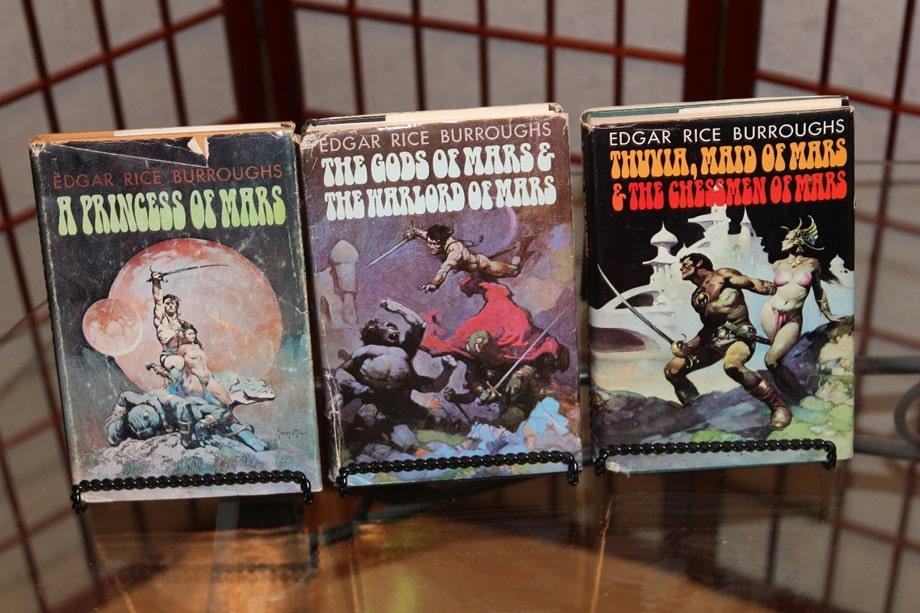 Edgar Rice Burroughs’ Barsoom novels: A Princess of Mars, The Gods of Mars and The Warlord of Mars, and Thuvia, Maid of Mars and The Chessmen of Mars (Science Fiction Books Club, July 1970, January 1971, and January 1973). Covers by Frank Frazetta
Edgar Rice Burroughs’ Barsoom novels: A Princess of Mars, The Gods of Mars and The Warlord of Mars, and Thuvia, Maid of Mars and The Chessmen of Mars (Science Fiction Books Club, July 1970, January 1971, and January 1973). Covers by Frank Frazetta
For sheer fun and adventure there’s nothing better in my opinion than Sword & Planet fiction (also called Interplanetary Adventure, Interplanetary Romance, or Planetary Romance). But exactly what is Sword & Planet fiction? Well, Edgar Rice Burroughs (ERB) created the prototype in 1911 with A Princess of Mars, which featured an Earthman named John Carter who is mysteriously transported to Mars, called Barsoom by its inhabitants.
The basic Sword & Planet story involves an earthman (rarely an earthwoman up to this point in time; 2025) on a strange world where he must use his wits, his muscles, and his sword against a host of human and nonhuman foes. The hero is generally chivalrous and the setting is an exotic alien world, often with multiple suns or multiple moons, populated by a variety of strange plants, animals, and intelligent beings. Magic is virtually non-existent, but there may be elements of “super-science,” such as open-decked flying ships or even ray-guns, although the latter take second billing to the blade. The emphasis is on swashbuckling sword fights, wild escapes, and desperate rescues.
[Click the images for Mars-sized versions.]
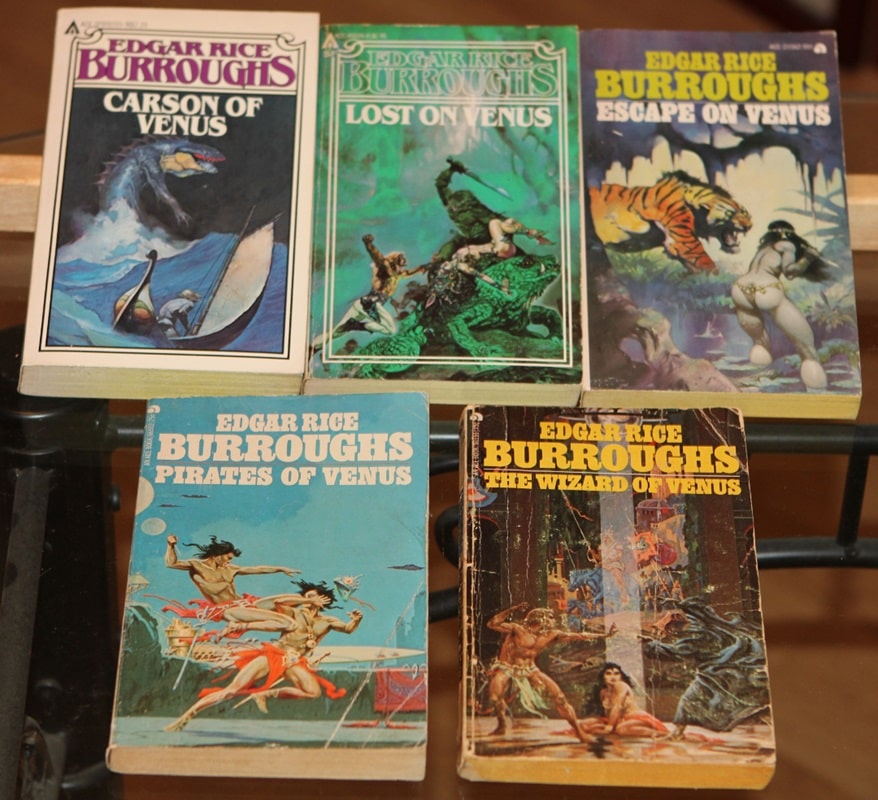 Edgar Rice Burroughs’ Venus novels: Carson of Venus, Lost on Venus, Escape on Venus, Pirates of Venus, and The Wizard of Venus (Ace Books, June 1979, June 1979, January 1974, March 1973, and January 1973). Covers by Frank Frazetta, Esteban Maroto, Frazetta, Roy G. Krenkel, and Roy G. Krenkel
Edgar Rice Burroughs’ Venus novels: Carson of Venus, Lost on Venus, Escape on Venus, Pirates of Venus, and The Wizard of Venus (Ace Books, June 1979, June 1979, January 1974, March 1973, and January 1973). Covers by Frank Frazetta, Esteban Maroto, Frazetta, Roy G. Krenkel, and Roy G. Krenkel
In addition to the Barsoom books, ERB also wrote a second Sword & Planet series, five books set on Venus (Amtor to the natives), featuring the earthman Carson Napier. Napier is intending to fly a rocket ship to Mars but ends up crashing on cloud-covered Venus.
He finds a world of giant trees and strange creatures, and, of course, a princess. Her name is Duare. Like Barsoom, Amtor mixes the primitive with super science, but the emphasis is on action, adventure, and personal combat with edged weapons.
 Escape on Venus, The Moon Men, Pirates of Venus, A Fighting Man of Mars, and The Chessmen of Mars (Ace Books, 1964, October 1962, January 1963, March 1963, and December 1962). Covers by Roy G. Krenkel, Ed Emshwiller, Krenkel, Krenkel, and Krenkel
Escape on Venus, The Moon Men, Pirates of Venus, A Fighting Man of Mars, and The Chessmen of Mars (Ace Books, 1964, October 1962, January 1963, March 1963, and December 1962). Covers by Roy G. Krenkel, Ed Emshwiller, Krenkel, Krenkel, and Krenkel
The five books in the series are:
1. Pirates of Venus
2. Lost on Venus
3. Carson of Venus
4. Escape on Venus
5. The Wizard of Venus
The Wizard of Venus is a novelette that wasn’t published until after ERB’s death. The book includes a second novelette called “Pirate Blood.”
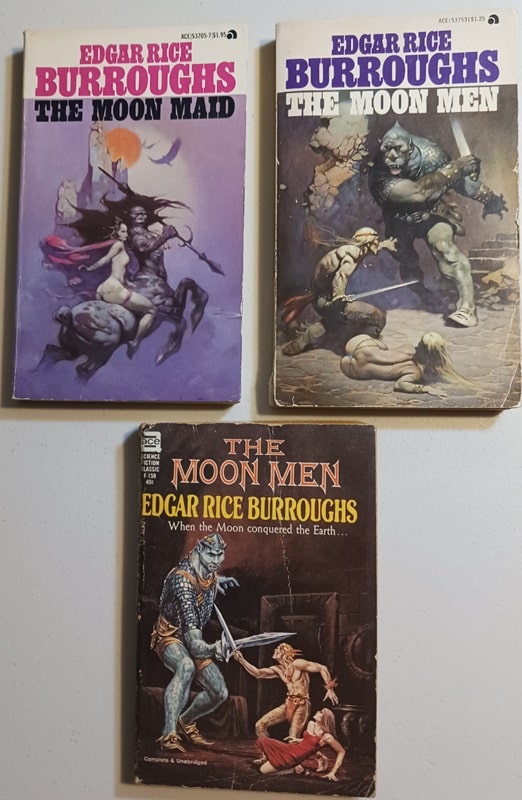 The Moon Maid, The Moon Men, and The Moon Men (Ace Books, January 1974, March 1974, and October 1962). Covers by Frank Frazetta, Frazetta, and Ed Emshwiller
The Moon Maid, The Moon Men, and The Moon Men (Ace Books, January 1974, March 1974, and October 1962). Covers by Frank Frazetta, Frazetta, and Ed Emshwiller
I enjoyed ERB’s Venus books a lot but they were not the equal of his Mars books — in my opinion. A lot of this has to do with Carson Napier. He’s no John Carter. He is a hero, and brave, but he makes plenty of mistakes and often needs to be rescued himself. He also uses more advanced weapons — essentially ray-guns — on many occasions. That means less “swashbuckling,” a minus for me. Certainly, though, if you’re interested in S&P fiction, the Venus books are a must.
The Venus books have been released in various editions. The pictures I have above mix older and newer editions. The older ERB books have covers and illustrations by Roy G. Krenkel, Jr, one of my favorite artists. Some of the newer ones have Frazetta images, and Frazetta was influenced by Krenkel.
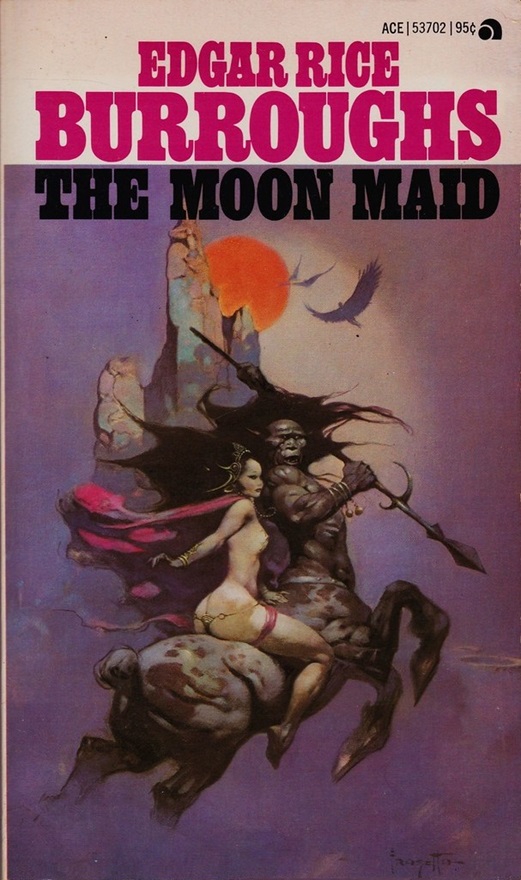 The Moon Maid (Ace Books, January 1974). Cover by Frank Frazetta
The Moon Maid (Ace Books, January 1974). Cover by Frank Frazetta
A series that I would have liked to see more of from ERB was his Moon Maid series. It’s sometimes described as a trilogy, but only the first book is full length. That’s The Moon Maid (copyright 1923). The sequels are novellas called The Moon Men and The Red Hawk (copyright 1925), which I first read combined in a later Ace book called The Moon Men. The novellas are reprinted from the pages of Argosy All-Story Weekly, where the tales were first serialized in 1925.
The Moon Maid has an awesome Frank Frazetta cover that is one of my favorites among his works. I have two copies of The Moon Men, one with a Frazetta cover and the other with a cover by Ed Emsh.
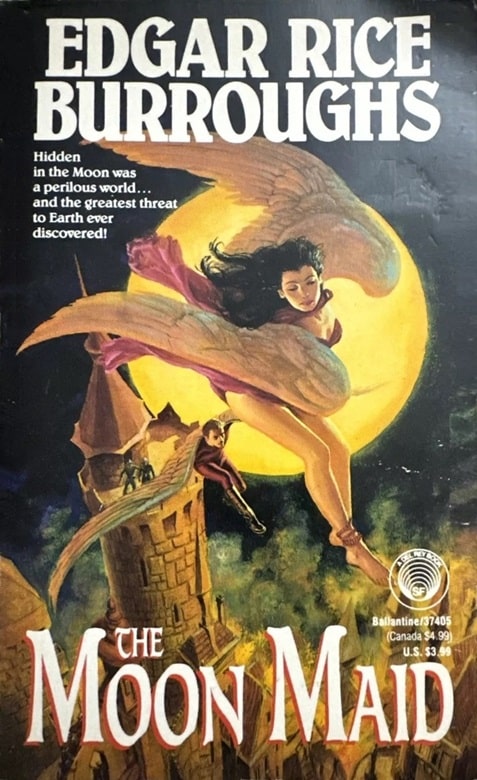
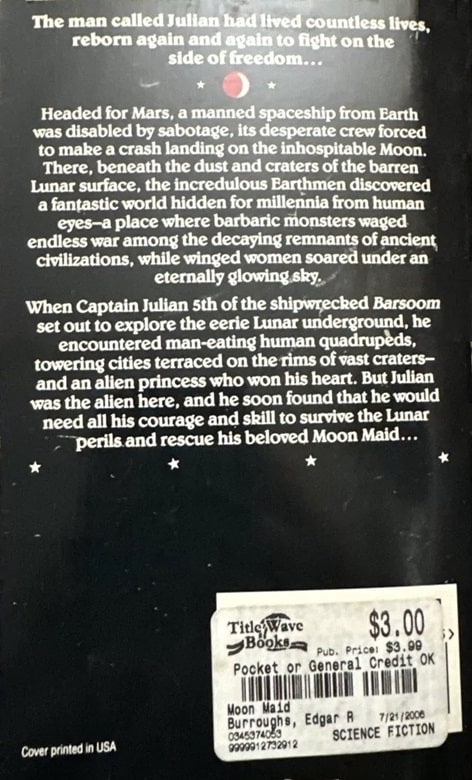
The Moon Maid (Del Rey Books, May 1992). Cover by Laurence Schwinger
The hero in The Moon Maid is Julian the 5th, an Earthman who has lived through many previous incarnations and remembers them. He is leading a rocket ship journey to Mars when the ship has to make a forced landing on the Moon.
They find an oxygen atmosphere inside the moon, and a wild land of strange creatures, including human-type and centaur-type intelligent races. Julian meets a princess of the human-type, Nah-ee-lah, and must rescue her. There’s lots of action and hand to hand combat, although not a lot of sword fighting. I would classify it as S&P.
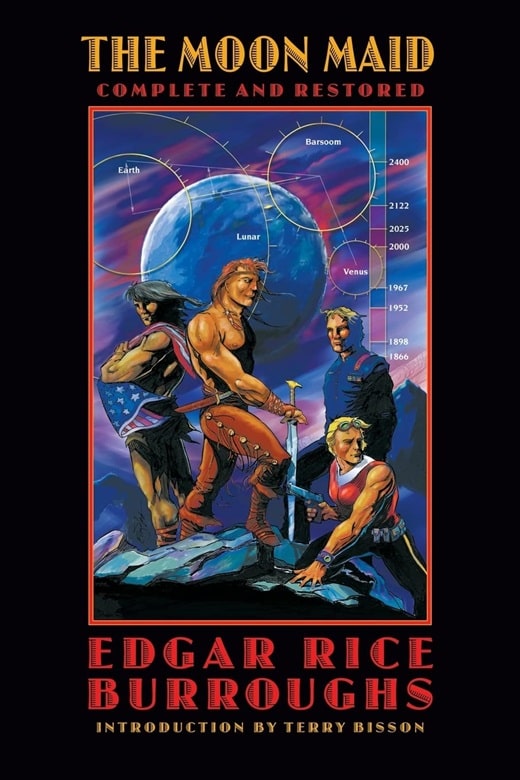
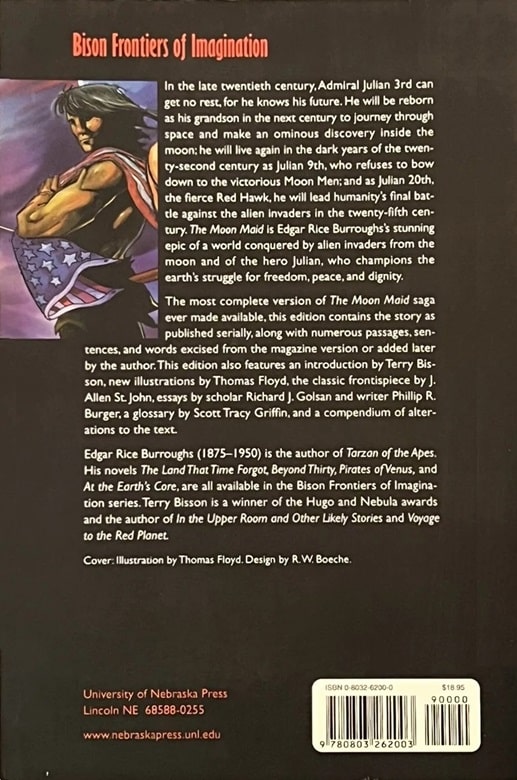
The Moon Maid: Complete and Restored (Bison Books, April 2002). Cover art by Thomas Floyd
The Moon Men and The Red Hawk are not — properly speaking — S&P fiction, because they take place on Earth. In The Moon Men, the Kalkar inhabitants of the Moon have conquered Earth. Julian the 9th, another reincarnation, leads a revolt, but it remains to “Red Hawk,” a descendent of Julian to finally free Earth from the Lunarians’ rule.
The three parts of the Moon trilogy have been published together by Bison books along with all kinds of extras (see above). I don’t have that copy yet but will get it for my collection. The series is one of ERB’s best.
More on Burroughs, including Tarzan and The Land that Time Forgot, in my next post.
Charles Gramlich administers The Swords & Planet League group on Facebook, where this post first appeared. His last article for Black Gate was The Masters of Narrative Drive.
Lividian update: Our first “larger print” edition: LEVIATHAN
Brian Freeman of Lividian Publications posted this news today on his Patreon.
The interior font size for LEVIATHAN was selected to keep the already high retail cost from going higher, but the text turned out smaller than I expected for some reason and I definitely understand it was too small for some readers. None of us are getting any younger! So, here’s what we’re going to do:
The Limited Edition, like the other Matthew Corbett Limited Editions from Lividian, will have a larger interior font size. But those are expensive books and down the road a bit.
In the meantime, Robert McCammon gave the OK for us to rush a “Larger Print” version of the book. This isn’t a traditional Large Print edition, but it uses the same font size as the Limited Edition, which is considerably more readable. See the photo above.
Note: there are significantly more pages in this edition but it contains no new content. That’s just the result of the larger text taking up more space. You’re not missing out on anything new.
This “Larger Print” version is a trade paperback to keep the price reasonable, but there will be a “real” trade paperback published later this year with new Vincent Chong artwork, just like most of the other books in the series, and it will also use this larger font.
You can order this “Larger Print” edition on Amazon now — or if you bought the trade hardcover directly from me and need one, please just send me an email and we’ll work something out: brian@lividian.com
Also, I’m trying to figure out the best way to send this to the Lividian tier supporters. I know in the past some of you haven’t wanted trade paperbacks, and some of you won’t necessarily feel a need to have this particular edition… I’m thinking it might get included in another shipment to save on postage.
More news soon!
Best,
Brian
P.S. Some of you have correctly guessed we have Matthew Corbett news for later this year. First of all, shhhhhhh… Secondly, we’ll be using the standard Limited Edition font size for the text in all editions of that title.
Spotlight on “Victorian Psycho” by Virginia Feito
Victorian Psycho is soon to be a feature film from A24 starring Margaret Qualley and…
The post Spotlight on “Victorian Psycho” by Virginia Feito appeared first on LitStack.
On McPig's Radar - Never the Roses
Did I already read this? Yes!
Am I still totally looking forward to getting this beauty in my eager trotters? YES!
Believe me: you want this book! It's utterly amazing and beautiful in and out!
Go preorder: I totally did.
 Never the Rosesby Jennifer K. Lambert
Never the Rosesby Jennifer K. LambertUNSTOPPABLE WAR. UNSPEAKABLE SINS. IMPOSSIBLE LOVE.
Genevieve Gornichec’s The Witch’s Heart meets Madeline Miller’s Circe in this epic and deeply emotional romantic fantasy debut by Jennifer K. Lambert. The hardcover edition features beautiful stenciled edges.
The Dread Sorceress Oneira has retired. She’s exhausted from fighting the endless wars of kings and queens, and has long accepted that her death is near. Alone at last but for a few uninvited companions―a near-mythical wolf, a goddess’s avatar, and a feline that embodies magic itself―Oneira realizes that she’s bored. On a whim, or perhaps at the behest of fate, she makes an unlikely trip to the most extensive library in existence: the home of her most powerful rival, the sorcerer Stearanos.
By recklessly stealing a book from him, Oneira inadvertently initiates a forbidden correspondence. Taunting notes and clever retorts reveal a connection neither has found―nor could ever find―in any other.
But Oneira soon learns that Stearanos, bound to a vile king, is tasked with waging war on the queen she once served. A relationship with him is far too dangerous to pursue despite their mutual desire―and yet, Oneira can’t seem to stay away.
A bond with Stearanos could alight the long-extinct flame of life within her… or it could destroy her entirely.
Expected publication July 8, 2025
Review: Grave Empire by Richard Swan

Buy Grave Empire OFFICIAL AUTHOR BIO: Richard Swan is a critically acclaimed British genre writer. His debut fantasy novel, The Justice of Kings, was an instant Sunday Times bestseller and has been translated into seven languages. His other work includes the Art of War and Great Silence trilogies, as well as short fiction for Black Library and Grimdark Magazine.
Richard is a qualified lawyer, and before writing full time spent ten years litigating multimillion pound commercial disputes in London. He currently lives in Sydney with his wife and three young sons.
FORMAT/INFO: Grave Empire will release on February 4th, 2025. It will be available in paperback, ebook, and audiobook formats.
OVERVIEW/ANALYSIS: Renata Rainer's job is a joke. As ambassador to the Stygion mermen, she largely has given up hope of ever being useful, given that the mermen want nothing to do with humans. But when two monks arrive claiming to have lost contact with the afterlife, suddenly Renata finds herself in the midst of a critical mission. The Stygion are some of the world's foremost arcana practitioners, and it's up to Renata to verify if recent portents do indeed herald an apocalyptic event known as the Great Silence. But Renata's not the only one interested in the Great Silence - and there are those who want help along the end of the world instead of stopping it.
Grave Empire is a haunting, harrowing journey that envelopes you in its atmosphere, while asking readers for patience in experiencing the actual payoff. This is a story of three individuals scattered across an empire who are realizing that a Very Bad Thing is coming. One is unraveling the secrets of a mysterious plague, another must travel through a warzone to consult with magic practitioners who can shed light on an ancient prophecy, and another is investigating strange reports on the frontier of the empire. Each story is compelling and unsettling, as our characters come to understand just how very wrong things are.
And yet when the dust settled, it felt like all that had been accomplished was learning that yes, a Bad Thing is coming and it is a VERY Bad Thing. The nature of the Great Silence is absolutely a satisfactory threat, and I look forward to seeing how our characters try to handle it, especially as some dominoes began tipping at the end of our story. But this first book is essentially all table setting. Here is the empire, here are the characters, here is the state of the mortal plane, here are some of the weird things that are happening. Will we explain how these weird things are tied together? Not really.
I do want to touch on the relationship between the Empire of the Wolf trilogy and this new The Great Silence trilogy. You do not need to have read the first trilogy to enjoy this new series; the events of Empire of the Wolf are as removed from the characters as the Napoleonic Wars are for us. Those events were definitely a big thing that happened, but they don't inform the characters' day to day lives.
The writing here is also more accessible than the previous trilogy. The first series was told first-person memoir style, while this new one is told across three third-person POVs. I think it also reflects the difference in tone between the two stories. Whereas Empire of the Wolf was a more personal journey of an individual caught up in world-shaking events, Grave Empire feels a little more big picture, a view of how several nations will grapple with a new threat.
CONCLUSION: I want to be clear, overall I really enjoyed Grave Empire, even if the ending left me a bit underwhelmed. I remain hopeful that the second book in this trilogy is going to take everything in the first book and use it for a fantastic sequel. In reading the first trilogy set in this world, I was lukewarm on book one, and then the sequel was one of my top reads the following year. Given how monumentally unsettling the nature of the Great Silence is, I think there's every chance this series will follow in its predecessor's footsteps.
Lowering the Hammer Snippet 2
Sitrep: So, Rea got the manuscript back to me early. So, I went through the usual stuff and shot it off to Goodlife. Shelley just said that they'd have it back to me by the weekend or in a week.
So, snippet 2:
Normal 0 false false false EN-US X-NONE X-NONE MicrosoftInternetExplorer4 /* Style Definitions */ table.MsoNormalTable {mso-style-name:"Table Normal"; mso-tstyle-rowband-size:0; mso-tstyle-colband-size:0; mso-style-noshow:yes; mso-style-priority:99; mso-style-qformat:yes; mso-style-parent:""; mso-padding-alt:0in 5.4pt 0in 5.4pt; mso-para-margin:0in; mso-para-margin-bottom:.0001pt; mso-pagination:widow-orphan; font-size:10.0pt; font-family:"Times New Roman","serif";}
Chapter 2
Atlas XIV
“So, where are we on things?” Catherine asked once the Admiralty had assembled. Among the senior leadership was her lover, Rear Admiral Elvira Varbossa. The assembled officers came to attention politely as protocol dictated.
Catherine glanced at the seat to the right of her that Captain Su was standing in front of. He wasn’t bad but she keenly missed Countess Newberry from time to time, specifically this time.
“We have the latest intel dump in, ma’am. It isn’t good,” the captain stated.
“Oh?” Catherine said as she took her seat at the head of the table. The standing officers took their seats quickly.
Going around the table were Vice Admiral Aden McRaven of Operations; Captain Sherman Su. head of ONI and Imperial Intelligence; Vice Admiral Hyman Preece, head of BuShips; Vice Admiral Latisha Nuert, head of BuPers; Vice Admiral Hsong Chen, head of Logistics; Vice Admiral Jennifer Post, head of Schools; Captain Lorna Justice, head of Medicine, and then Elvira as head of special engineering operations aka the battle moon itself.
Many of the officers around the table held double positions in the civilian cabinet.
Everyone felt the pressure of their position. But the cutthroat attitude was missing. Catherine was known to be ruthless but she had put an emphasis on quality and on civility. She was pushing professionalism and turning over a new leaf. After over a decade as Empress, she was starting to make some headway.
Well, I had been making progress until the damn Fed spy had gotten on board and broadcast our location to the galaxy and wrecked a lot of stuff, she thought sourly. May you rot in hell you son of a …. she cut the errant thought off.
“We have the latest news intercepts. The war in Tau sector has more or less ended several months ago,” Captain Su reported.
“Which?” Admiral Chen asked.
“Excuse me, sir?”
“Is it more or less?” Admiral Chen asked.
“Ended as in they are in a truce and have been undergoing extended peace treaty talks,” Captain Su explained.
“Oh.”
Catherine grimaced. She had read the précis and wasn’t happy with the news.
“There has been a catastrophic change in leadership with the Taurens after the battle of New Tau Metropolis. Once their fleet was run down and destroyed, their government fell and a new one was elected to replace them. They sued for peace.”
“Darn,” Catherine said mildly. The distraction was one reason they’d been able to continue to operate. Clearly, that was coming to an end. That meant the Federation would be returning its attention to them soon enough.
Not good, she reminded herself.
“The Secretary of State Moira Sema is traveling to the sector now to finalize the peace treaty,” Captain Su reported.
“How did the Federation win?” Admiral Preece asked. “I thought they were in trouble given the distance and weight of metal against them?”
“Well, they managed to fight a rearguard action to delay the enemy, primarily around their carrier forces. The Taurens left themselves vulnerable to fighter and bomber strikes repeatedly. That delay allowed the Feds to get their wormhole open,” Captain Su explained. He used his implants to control the view screen nearby to show a series of still images and even a short video clip. “They sent two fleets over which took the Taurens with Fifth Fleet.”
“Oh,” Admiral Preece said. He looked thoughtful.
Looks were exchanged around the table.
“That leads to the second bit of really bad news,” Captain Su stated. The room grew tense. “The Federation has activated the gate here in this sector. They now have a straight shot from Rho to here.”
“Two fleets,” Catherine murmured. All eyes turned to her slowly. The admirals were not happy about the last news. Her eyes flicked back and forth. She’d read it but it hadn’t sunken in until that moment that the Federation was continuing to expand and grow. Meanwhile, her people were struggling to make good on what they had.
It just drove the point home that they were pirates. They had no business standing toe to toe with the Federation anymore.
“We need to accelerate the repairs and get the hell out of here,” Admiral Chen said firmly. That earned a few nods around the table.
“I’d love to but we are still making good on the repairs from the recent sabotage,” Catherine said with a nod to Elvira.
All eyes shifted to the raven haired admiral. “Yes, well, we have made good on most of the physical damage. But we do have some issues there. The software is still an ongoing trial to sort out and fix. The spy was fiendishly clever in putting viruses everywhere,” Elvira reported.
A few people grimaced.
“Stop making excuses. Can you get us out of here or not?” Admiral Post asked testily. It was a sign of the stress that she was under that he spoke to the Empress’ lover in public.
“I’m not making excuses, I am explaining the situation,” Elvira said before anyone said or did anything. Her eyes cut to Catherine briefly to quell Catherine stepping in. She could and would fight her own battles.
“At the moment, our risk assessment puts us at a 20 percent chance of success if we jump now.”
“Twenty?” Admiral Post asked. She didn’t look like that she liked that number at all.
Elvira nodded grimly and pulled the latest sim up on the main screen. “That is correct. The sabotage also slowed our forward progress. We are now getting back on track there.”
“Can we accelerate it if we raid for parts? The Feds make good stuff I believe,” Admiral Chen stated.
There were hopeful and even a few mischievous expressions around the table at that idea.
“That is very true, but …,” Elvira looked to the captain.
“The risks aren’t worth the exposure I’m afraid,” the captain said with a shake of his head.
“Without risk there is no reward,” Admiral Chen said doggedly.
“You’d think that, but in doing the risk assessment, we noted a few things. First, the components we need are no longer easily accessible here. The only two places we can source them are in the gate system and in the system capital. Both of which are heavily guarded by Second Fleet task forces.”
“And potentially another fleet by now,” Aden said quietly.
“Another problem is their built-in security and safeguards. Any hardware we catch will come with those problems that could set us back even further,” Admiral Preece warned.
A few people winced.
“Correct. We have become aware of some logistic nodes, but they are no doubt honey traps arranged for us to send a raiding force to,” the captain stated.
A few more people winced.
“I’d rather not lead them back here or have another raid go bad,” Admiral Post said dryly.
More than one person around the table winced again. Rear Admiral Paul Race, the former second-in-command of operations, had led a raiding force to take on a convoy of grav emitters destined for the gate system several years prior. Somewhere along the way, his task force had been spotted and ambushed. The Federation had done an excellent job turning the tables on the raiders.
A few ships had made it back; the admiral’s flagship had not been among them.
Catherine missed him for a brief moment. He had been a good fleet commander, solid and dependable. Pity he’d walked into a trap and gotten his fleet torn apart. She missed those crews and ships too.
“So, those are out obviously,” Admiral Chen said sourly.
“Correct. The only other known source is the factories which are located in Rho and thus out of our reach,” the captain stated.
“Damn,” Admiral Chen muttered.
The captain nodded. “My sentiments exactly.”
“There has been a recent uptick in scouting along the western flank. It is … concerning,” the captain stated with an eye to the head of operations.
Admiral McRaven nodded grimly.
“Can we wake some of the sleepers? See if they could help? I don’t know, isolate them like before?” Admiral Post asked. She looked over to Latisha and then back to the captain.
Catherine puckered her lips. She didn’t like the idea and the security risks involved.
“The problem is that they know something is off over time. Keeping them distracted with work and with sex helps, but eventually, they start to wonder. Like why there are only humans around them. That is a big one.”
“They are ticking time bombs,” Admiral Preece muttered. “Not worth the risk.”
“Well, I’d hate to wake a damn bear,” Admiral Post growled.
“We can’t. We don’t have any,” Latisha stated as she glanced down at her tablet. Admiral Post turned to her in surprise. “All of the aliens and Neos were turned over to the gladiator pits or to R&D or um … others. We actually have two hundred thousand humans and light chimera left in stasis.”
“I thought it was less?”
“We did another inventory after the recent incident and lockdown. There was an original crew of civilians and a skeleton crew of naval personnel of one hundred thousand people. Of those, roughly fifteen thousand were human form. We kept those obviously. Over time we added to the collection with people that were found in stasis pods that were brought in from abroad. Some we brought from the homeworld,” Latisha explained.
“Oh.”
Catherine nodded slightly. There had been some rancor about her including them in the evacuation. She didn’t regret the decision, though she didn’t trust the sleepers to help any more. The last bout of sabotage from a sleeper had cost them additional time and resources to set to right.
That and seeing the military personnel melt into puddles of goo when they activated their suicide nanites was … horrifying. It also did some damage to people and equipment around them.
“Well, what about the civilians? Can’t they help?” Admiral Chen demanded.
Captain Su shook his head.
“Why not?”
“They don’t have the requisite keys and tech,” Latisha interjected as the captain opened his mouth to reply. He paused, closed his mouth and then nodded with a glance to the head of BuPers.
“Damn it!” Admiral Chen growled as he clenched his fists.
“We’ve flipped a few of the civilians but oh so few. None have what we currently need. They have the general idea but not the specific knowledge that is required,” Captain Su stated. “Most were either low level techs or middle management.”
Admiral Chen turned to Elvira. “Wait, why only 20 percent? I know engineers; you are all conservative and like to think of yourselves as miracle numbers. What is the real number?” he demanded.
Eyes shifted to Elvira again. Some were amused, a few accusing.
The raven haired flag officer squared her shoulders slightly. “Twenty percent is the average from this week’s simulations,” Elvira stated firmly. She flipped her hands slightly in an indication of a shrug and something out of her hands.
“It was higher before,” Admiral Post pointed out.
“Before the sabotage you mean?” Aden asked mildly.
“No, I mean two weeks ago,” Admiral said, eyes still locked on Elvira.
“We had a node fail an inspection. It is currently being swapped out and then we have to tune the replacement and those around it,” Elvira explained. She hit a button on her tablet and then swiped the report to the main screen. A window opened and a node blinked. The cluster then blinked a different color around it.
All eyes turned to the report.
“Oh. Damn.”
“We’ll naturally rebuild the node and use it somewhere else that is less critical. But the components are scarce. It will be less … reliable. Scabbing in civilian and military grade components that were not designed for the purpose is … sketchy. Which is why we have a lot of variables to consider.”
There was a soft rustle, almost like a sigh of frustration from the assembly.
“Right. As to being conservative, you are correct. Engineers tend to be conservative because we do not want to create a situation of disappointment and we do not want to have a piece of equipment fail under load. Such things depend on a lot of variables that is outside of engineering too, however. The status of the helm team for one. The status of real world conditions, the engineering hardware as I mentioned, software, and so on.”
“Real world?” Admiral Post asked with a puzzled frown.
“If we are under attack or not. If we are rushed or taking damage, the odds of survival drop to single digits rather quickly,” Elvira stated flatly.
“Oh.” Admiral Post scowled. “Shit,” she finally said as she sat back in disgust.
Elvira nodded. “My sentiments indeed,” she murmured as she looked around the table.
“I hate to even suggest this, but what if we pull apart one or more of our capital warships? The biggest ones we have are super dreadnoughts. We have thirty-five of them, right? And we do have those three monitors but they are in mothballs.”
There was an instant look of hope from the assembly. Admiral McRaven didn’t look happy at sacrificing a ship or two under his command, but he was curious. The looks didn’t last long, however.
Admiral Preece shook his head in unison with Elvira. Admiral Chen looked from one to the other and then sat back in disgust. “No? Why not?”
“It is a matter of scale. The nodes we need are nearly the size of a dreadnought,” Admiral Preece explained patiently.
Admiral Chen blinked and then his lips puckered. “Damn.”
“Yeah.”
Faces fell around the table.
“Yeah, it is a matter of scale, which is a bit off,” Admiral Preece said dryly.
That’s what she said echoed perversely in Catherine’s mind but was left unsaid. She didn’t want to antagonize anyone. They needed to focus and work together to solve the problem.
“We can strip a few ships to make one node. It will have half the power of an all-up node,” Elvira said. She frowned as she tapped at her tablet until she found the relevant file and then loaded it and then swept up to push it to the main screen.
They looked at the bastardization of a bunch of nodes from a capital ship clustered into a hole on the hull of the battle moon. “We actually have done that on a few points on the hull. But they are notoriously hard to tune and stay tuned. It is also a pain in the ass to modify the mounts and it all sorted out.”
“Damn it!” Admiral Chen snarled. “Spirits, damn it!” he snarled.
“Let’s not tempt infernal retribution any more than we need,” Admiral Preece said dryly.
“I honestly think it is a good idea. We’ve already pulled all of the nodes from the monitor and other material in the boneyard,” Elvira stated slowly with a look to Admiral Preece. He nodded. “We’re at the point where we have too few options and manufacturing replacements is clearly out. So, we may need to give it a shot. If we keep the node clusters together, we would hopefully have an easier time tuning them. But it would only get us so far. A few extra nodes, maybe parts to rebuild two of the existing nodes to get them operational again.”
“But …,” Aden frowned. “What about the crews?”
“We pull them and distribute them to the other ships that have holes in their ship companies until we can find replacement parts of course,” Latisha said. “This would actually help us a bit,” she said with a look to Catherine.
Catherine cocked her head thoughtfully. Most of the ship companies were at 70 percent strength. The capital ships drew the most manpower. Since they were more or less anchored in place, there was no real call to have them fully manned at all times.
“I suggest we also shut down all construction programs. Finish anything we have left of course but then focus the yards on repairs and getting the ship online. We can’t hide here forever,” Admiral Preece offered.
Catherine looked to the chief engineer in surprise. He shrugged and flapped his hand.
“It’s not like the ships we can produce now can stand a snowball’s chance in Hades against the Fed ships at the moment anyway,” Admiral Preece said sourly.
Catherine’s gaze shifted to the head of operations. Aden had recently been pushing to swap out the old hulls for new. She had thought he was right; the old hulls were just that, old. No matter how many times they had been rebuilt they’d never stand up to a modern warship and definitely not to the Fed ships.
Besides, she had recently passed a resolution, backed by the assembly of pirate lords, to not fight stand-up battles with the Feds anymore. The pirate adage of “fight to runaway” was in full force.
“Very well. Stop production of new hulls but finish those you can. Mothball the rest. You can work on individual ships as resources dictate. Focus everything on Atlas.”
“Yes, Your Highness,” Admiral Preece said with a note of relief in his voice.
“As to the proposal, pick one super dreadnought with good nodes. One that we can use easily. Pull her nodes for the ship and then pull components for the other ships. Transfer the crew where you see fit,” the empress said with a nod to the head of BuPers. Latisha nodded back.
“The officers won’t like it,” Aden observed.
“We’ll find a posting for them,” Latisha stated.
“They aren’t paid to like it. They are paid to do their duty and serve,” Catherine said firmly. That ended the growing dissent. “Get it done. If it works, we’ll look into an additional ship.”
“Shouldn’t we go with ships with the lowest efficiency levels? That way we’re not sacrificing our best?” Aden asked hopefully.
Catherine recognized the ploy and she empathized with it. She even agreed, but she knew there had to be a reason for wanting the best hardware. She turned to Elvira.
“It doesn’t do us any good if the hardware is subpar,” Elvira pointed out. “For this to work, we need good hardware—solid, dependable, and reliable.”
Catherine nodded. “Figure it out and have the final proposal on my desk in two days.”
“Yes, Your Majesty.”
“Moving on,” Catherine said. She looked to Captain Su. “I talking with Latisha and we are frocking you to Commodore, Sherman.”
The captain sat up straight.
“If you continue to do well, we will make the promotion permanent,” the empress stated.
“Thank you, ma’am. I’ll try my best.”
“Good. We will hold the ceremony in a few days. I’ll let the staff handle the details. Now … next on the agenda …”
Howard Andrew Jones, a Mentee’s Perspective
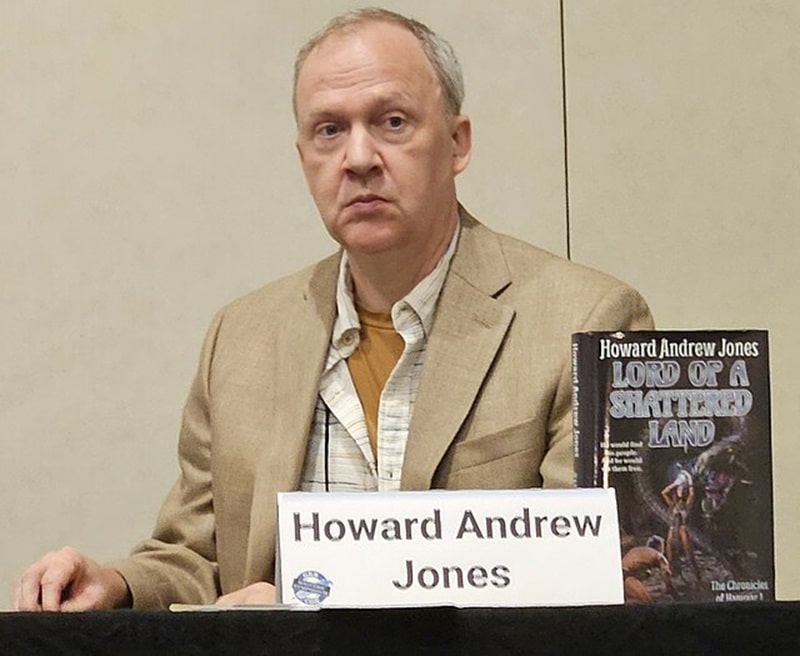 Howard Andrew Jones at GenCon, 2023
Howard Andrew Jones at GenCon, 2023
In 2019, I had an idea: a lot of my friends loved reading sword and sorcery fiction, but they didn’t write it. They would say, “One day.” Many of my undergraduates also expressed interest in writing fantasy, but they often felt discouraged by form rejection letters (genre magazine slush piles are epic). Having studied the history of genre fiction, I knew about the old tradition of “fanzines”— not-for-profit amateur publications that provided a low-stakes outlet for new writers. Just submitting work, collaborating with an editor, and seeing it in print can transform someone’s self-image from being just a reader to being a writer.
So, after some conversations with friends and a bit of encouragement, I started thinking seriously about launching my own zine.
As an academic, I’m deliberate by nature. I like to consult and take my time. Honestly, if I could have formed a committee for this, I probably would have. Instead, I decided to email someone: Howard Andrew Jones.
[Click the images for larger versions.]
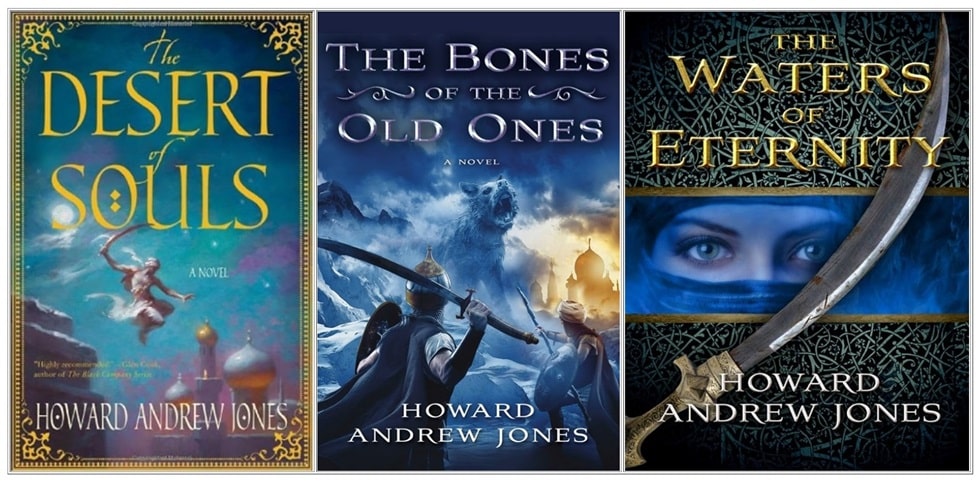 The three Dabir and Asim volumes: The Desert of Souls, The Bones of the Old Ones, and the collection The Waters of Eternity (Thomas Dunne Books, February 2011, December 2012, and November 2011). Covers by Charles Keegan, Steve Stone, uncredited
The three Dabir and Asim volumes: The Desert of Souls, The Bones of the Old Ones, and the collection The Waters of Eternity (Thomas Dunne Books, February 2011, December 2012, and November 2011). Covers by Charles Keegan, Steve Stone, uncredited
At the time, I didn’t know Howard personally, but I knew of him. He was a celebrated name in sword and sorcery. Howard had published an e-zine (Flashing Swords) in the genre, written essays and edited for Black Gate, and authored an incredible series of novels set in a sword-and-sorcery-inspired Arabia featuring Dabir and Asim (The Desert of Souls and The Bones of the Old Ones). He was also working on a new trilogy, The Ring-Sworn Trilogy, and I had already read the first book.
On top of all that, Howard had written several fun Pathfinder RPG novels, and he was editing Tales from the Magician’s Skull, the magazine for contemporary sword and sorcery fiction, published by Goodman Games. I loved that magazine. If anyone could give me advice on starting a zine, it was Howard.
I didn’t expect much when I emailed him. I wrote a long message, gushed a bit as a fanboy, and sent it off. Honestly, I wasn’t really expecting a response.
The next day, I was in my campus office grading papers when my office phone rang. My office phone never rings. In my ten years at CNU, maybe one student has ever called me. It’s practically an artifact – a dusty relic of a bygone era. My first instinct, as a millennial, was to let it go to voicemail. That’s what you do: let them leave a message and call back after some breathing exercises.
But for some reason, I picked it up.
“Hello?”
“Jason?”
“Yeah, this is Jason.”
The voice on the other end was calm, relaxed, with a kind of deliberate enunciation.
“Heeey, Jason! This is Howard.”
“Howard?” I said, not quite connecting the dots.
“Howard Andrew Jones. You emailed me about a magazine idea.”
I still get a little emotional thinking about that first call. Maybe I’m projecting, but I was immediately surprised, disarmed, and touched. Howard had gone out of his way to call me – call me! My office number isn’t even in my email signature, so he must have looked me up online to find my CNU contact info. I hadn’t even expected a reply, and here was this great author, taking the time to phone me.
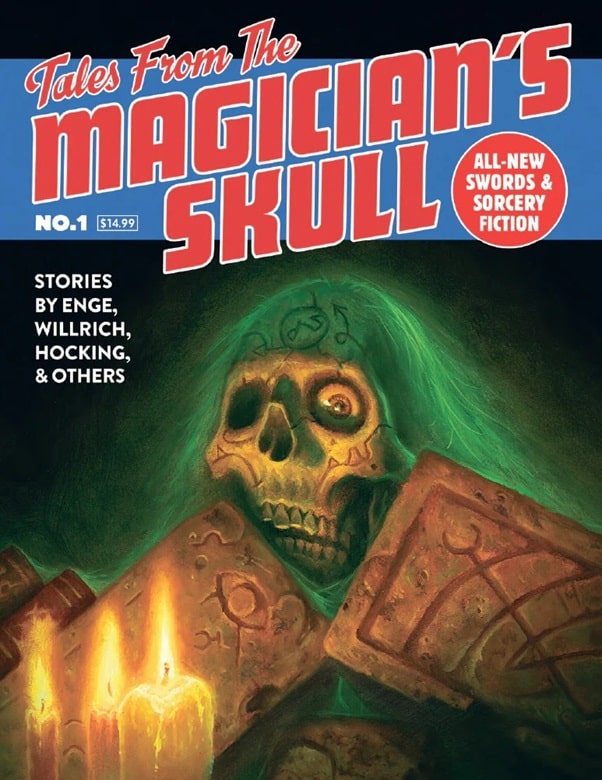
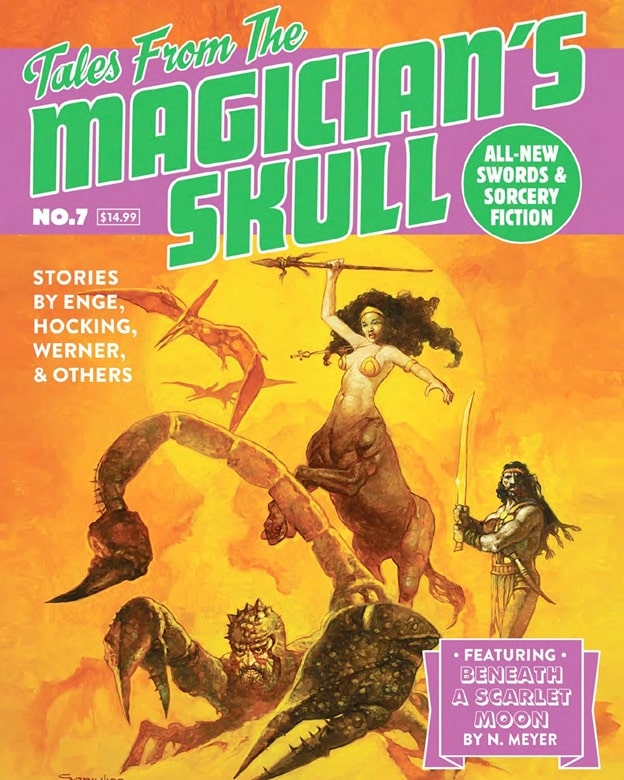
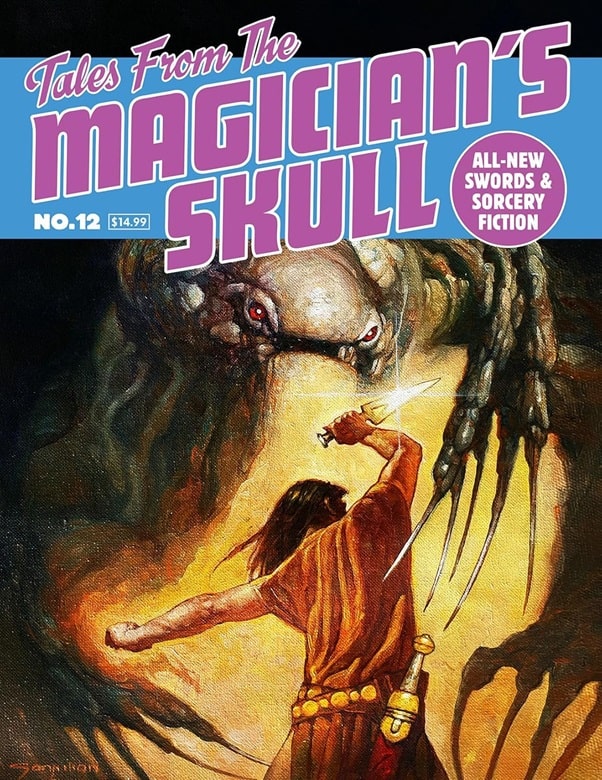
Tales of the Magician’s Skull, edited by Howard Andrew Jones. Issues 1, 7, and 12
(Goodman Games, 2017, 2022, and 2024). Cover art by Jim Pavelec and Sanjulian
I was a bit starstruck when we first talked. I’m already an awkward person, but the awkwardness was dialed up as I tried to gather my bearings. Howard, however, was so kind, calm, and genuinely enthusiastic about fiction, writing, and fantasy literature that I found myself speaking to him like an old friend. I’m pretty sure we talked for over an hour during that first conversation. I remember he was multitasking while on the phone – taking out the trash or doing yard work.
In the years that followed, whenever I spoke to Howard, he always seemed to be en route somewhere – driving to town, running errands, sometimes saying, “Hold on, I’ve got to grab this thing.” He felt real and grounded in a way that made people feel at ease. He gave off this sense of being completely unaware of how cool he was or how others saw him – or, if he did know, he just didn’t put much stock in it.
Over the next five years, Howard and I stayed in almost constant contact. We texted regularly. Often, he’d reply to a message with something like, “You free? Driving to town.” When I started my magazine and created an associated Discord server, he joined and became as active there as anyone, if not more so.
His comments were always supportive, kind, and encouraging. He shared favorite authors, thoughts on prose style, and a steady drip of wisdom for aspiring writers. Whenever anyone mentioned his work, he would chime in, “Thanks for reading it,” “Glad it worked for you,” “Really appreciate the kind words.”
Outside of Discord, we talked on the phone often. One thing I noticed was that Howard frequently mentioned his friends – not in a name-dropping way, like he wanted you to know he knew big authors, but in a way that made you feel like you were part of this collaborative effort, this network of fellow creatives. To him, it seemed, writing wasn’t a solitary pursuit but a shared craft. It was like Howard was always attending a seminar on fiction, and his calls were a way of touching base to see how your progress was going.
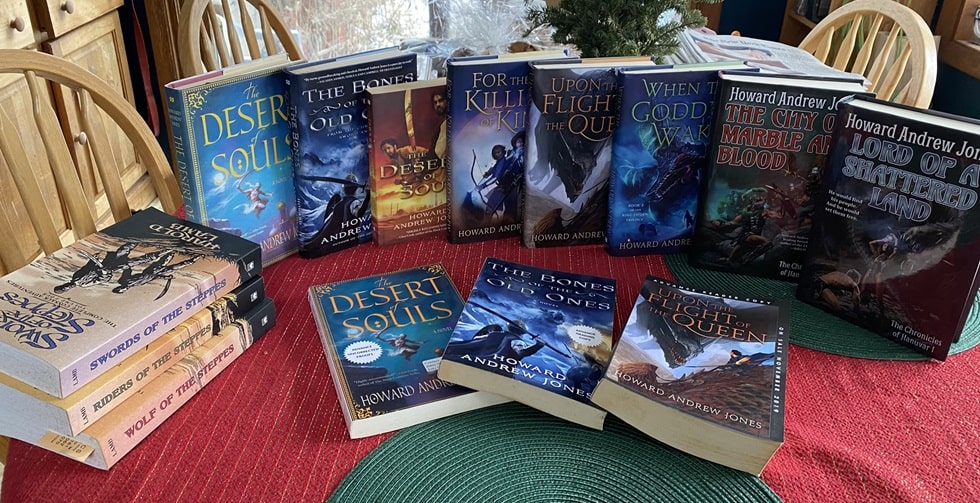 The books of Howard Andrew Jones
The books of Howard Andrew Jones
For instance, he’d say something like, “Hocking and I were talking about dialogue – how it needs to reveal character but economically, like in hardboiled detective fiction” (I’m paraphrasing). From the way he spoke, I got the sense that Howard had a lot of writer friends, and they talked about the craft of writing the way master carpenters might talk about solving technical problems with wood.
Fandom can get a little gossipy, but Howard never said a negative thing about anyone. He was almost stubbornly kind and assumed the best intentions from people. Being in touch with him felt like being welcomed into a very supportive club. Over time – without me even realizing it – Howard became something of a mentor or even a sensei in sword and sorcery writing.
At first, we just talked about sword and sorcery (a genre he was deeply opinionated about – he really didn’t like Tros of Samothrace (“Bounced right off it)), but our discussions evolved into broader topics: writing, work, heroism, and how storytelling affects people’s lives. I can honestly say I learned a lot about writing from him, at least an MFA’s worth, or more.
I met Howard in person three times over the six years I knew him. I saw him at GenCon, the big gaming convention that also includes a section for genre writers. We sat on several panels together discussing sword and sorcery fiction. He attended Howard Days, a celebration of Robert E. Howard, the pulp author who created sword and sorcery (yes, it gets confusing). And then I saw him again at GenCon this past August of 2024.
In August, aside from a persistent leg injury, Howard seemed… OK. I need to be honest and say he struck me as a little blue at GenCon, and he suspected it was due to the injury or the associated medication treating it. He had every reason to be happy. He had just published the first two books of his Hanuvar series. If I remember correctly, book three, Shadow of the Smoking Mountain, had just come out or was coming out. At the convention, he gave me an ARC and signed it with the words, “Find a way or make one.” I took this as a nod to the writer’s life, a reminder to persevere and create despite the challenges.
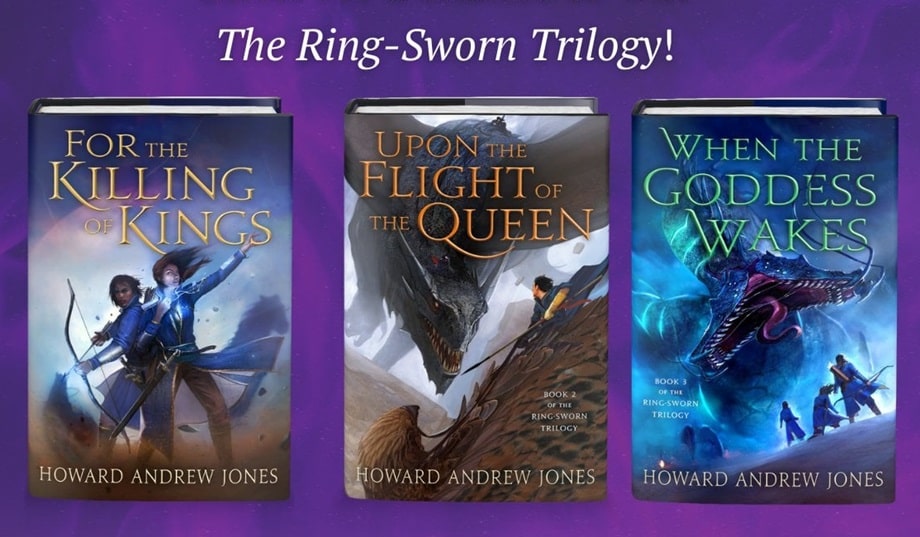 The Ring-Sworn Trilogy by Howard Andrew Jones (St. Martin’s Press, 2018-2021). Covers by Lauren Saint-Onge
The Ring-Sworn Trilogy by Howard Andrew Jones (St. Martin’s Press, 2018-2021). Covers by Lauren Saint-Onge
On the last day of GenCon, literally just before leaving, Howard, my wife Nicole, and I had lunch together. It was the first time Howard had met Nicole. She joked and referred to Howard as “my friend in my pocket” because I was always texting with him. I laughed and told her, “You don’t understand – this guy is so cool. He’s the nicest guy you’ll ever meet.”
That might sound like grief-motivated hyperbole now, but, in hindsight, it wasn’t. That’s exactly how I spoke about Howard before I knew anything was wrong.
Nicole and I had lunch with him, and of course, they hit it off. I can’t recall the details but Howard was fascinated with Nicole’s life growing up on a farm (did Howard come from a rural background?). After the meal, Howard said he was glad to have met her.
We left the restaurant. There were hundreds of people in the corridors at GenCon, a veritable sea of humanity, and Nicole and I were ready to leave, luggage in hand. So, we said our goodbyes. I had no idea it was the final goodbye. Howard gave me a hug and said, “Well, safe travels to you and your beautiful wife. And, keep writing.” Then he disappeared into the crowd.
A few weeks later, I learned he had gone to the hospital with acute symptoms.
I’m still in the anger phase of all this. Howard was such a good guy. It felt like, as a writer, he was hitting his peak. In my view, he had so much more to give the world – not just through his novels but through who he was as a person. I know my story is just one of many similar ones. That’s the kind of person Howard was: everyone who met him seemed to come away with a story about his kindness. This tragedy couldn’t have happened to a more undeserving person.
Howard, you’ll be missed, man. Thanks for being you.
Jason Ray Carney is a Lecturer in Popular Literature at Christopher Newport University. He is the author of the academic book, Weird Tales of Modernity (McFarland), and the fantasy anthology, Rakefire and Other Stories (Pulp Hero Press). He edited Savage Scrolls: Thrilling Tales of Sword and Sorcery for Pulp Hero Press and is an editor at The Dark Man: Journal of Robert E. Howard and Pulp Studies and Whetstone: Amateur Magazine of Sword and Sorcery. His last article for Black Gate was a review of Lord of a Shattered Land.
7 Author Shoutouts | Authors We Love To Recommend
Here are 7 Author Shoutouts for this week. Find your favorite author or discover an…
The post 7 Author Shoutouts | Authors We Love To Recommend appeared first on LitStack.
Graphic novel: Final Cut by Charles Burns

Book links: Amazon, Goodreads
ABOUT THE AUTHOR: Charles Burns grew up in Seattle in the 1970s. His work rose to prominence in Art Spiegelman's Raw magazine in the mid-1980s and took off from there, for an extraordinary range of comics and projects, from Iggy Pop album covers to the latest ad campaign for Altoids. In 1992 he designed the sets for Mark Morris's delightful restaging of The Nutcracker. He's illustrated covers for Time, the New Yorker and the New York Times Sunday Magazine. He is the official cover artist for The Believer magazine. Black Hole received Eisner, Harvey and Ignatz awards in 2005. Burns lives in Philadelphia with his wife and two daughters.
Publisher: Pantheon (September 24, 2024) Length: 224 pages Formats: Hardcover, ebook
It’s been a long wait -ten years, to be exact-but Charles Burns is back with Final Cut, a weird, sad, and beautifully drawn trip into the mind of an awkward teenage filmmaker named Brian. Set in the early ‘70s, the story follows Brian as he and his friends make a low-budget horror movie on a camping trip.

Everything revolves around Laurie, Brian’s red-haired crush, who becomes his muse, his obsession, and, ultimately, the centerpiece of a story he might be rewriting in his head.

As a result, Final Cut can initially feel like a simple coming-of-age story about a group of friends making a low-budget film in the woods. But true to Burns’ style, there’s so much more beneath the surface. As Brian edits his movie, it becomes clear he’s also “editing” his memories of that summer, creating a version of events where he has more control—and maybe even the happy ending he never got.
This comic has great vibes. You’ve got razor-sharp art that’s stunning, a creeping sense of unease, and characters you’re not quite sure how to feel about. Since I love unreliable narration, I loved the eerie, dreamlike atmosphere. Brian’s a loner who’s into art and movies—cool enough—but he’s also kinda creepy. He films Laurie without her knowing, sketches naked pictures of her, and lurks outside her tent at night. His version of events might not be a full story.

That’s the hook here: is this all really how it went down, or is Brian “editing” the summer in his head to make it more palatable? He’s a filmmaker, after all, and Final Cut plays with that idea of memory as a movie you can tweak. The whole thing has this dreamy, slightly unsettling vibe, like you’re stuck in Brian’s head with him.
The art? Absolutely stunning and otherworldly. Burns’ haunting artwork is unparalleled, as he effortlessly shifts between grounded realism and surreal horror. The color palette—rich blues, stark whites, and deep reds—heightens the unsettling atmosphere, while the splash pages and film-like sequences are nothing short of stunning.

If there’s a downside, it’s that the pacing can be uneven and its core is quite simple, really. Unrequited teenage love, even with all the surreal touches, might not sound like much on paper. And yeah, some parts drag, like the repetitive “making the movie” scenes. But by the end, Final Cutk hits you with this quiet, bittersweet sadness.
Final Cut is a beautifully weird, unsettling, and surprisingly tender look at love, art, and the stories we tell ourselves. If you’re a fan of Charles Burns or just love weird, thoughtful comics, this one’s worth the ride.
Book Review: At the Bottom of the Garden by Camilla Bruce
I received a review copy from the publisher. This does not affect the contents of my review and all opinions are my own.
 At the Bottom of the Garden by Camilla Bruce
At the Bottom of the Garden by Camilla Bruce
Mogsy’s Rating: 3.5 of 5 stars
Genre: Horror
Series: Stand Alone
Publisher: Del Rey (January 28, 2024)
Length: 384 pages
Author Information: Website | Twitter
I’ve been a fan of Camilla Bruce ever since I read You Let Me In, which won over with its dark, complex characters and unsettling themes. Her stories so often blur the lines between the real and the supernatural, and her newest novel At the Bottom of the Garden seemed like it would too—a blend of eeriness and whimsy and atmosphere. However, certain aspects also fell short of my admittedly high expectations.
The book introduces Clara Woods, a conniving woman who seizes on an opportunity to reshape her future when a tragic climbing accident claims the lives of her brother and his wife, leaving her as the sole guardian of their two orphaned daughters. Ambitious and cunning, Clara dreams of becoming the head of her own diamond business but lacks the funds to make it happen. With her late brother’s estate now in the hands of his children, Clara begins to plot her way into gaining access to their inheritance.
Still grieving the loss of their parents, 14-year-old Lily and 9-year-old Violet suddenly find themselves transported from their lavish townhome into a decaying manor in the countryside, living with their aunt whom they hardly know. Clara seems kind enough, and says all the right things, but the girls know better. Each secretly harbors a unique gift—Lily can “see” the emotions of others as different colors, while Violet has an inexplicable connection to the realm of the unliving. As their aunt’s manipulative behavior grows worse, the sisters begin to suspect her motives, especially when the house begins to feel increasingly suffocating and oppressive. One day, Violet’s mysterious ability unleashes a long-buried secret, and before long, Clara is surrounded by the ghosts of her past. A tense battle of wills ensues as Clara isn’t about to back down, while the girls grow increasingly defiant and emboldened by their powers.
The story primarily unfolds through chapters alternating between the perspectives of the three characters. Clara is a real piece of work—a greedy, social-climbing widow who is secretly delighted when her half-brother dies and only sees taking care of his daughters as a means to an end. Lily is more mature than her age would suggest, quietly observant and deeply protective of her younger sister. Violet is pure innocence, wanting only to please. Each POV adds a layer to this precarious dynamic, as the girls’ resistance causes Clara to push to take her scheming to the next level.
The writing style is interesting in this one, though it also strongly reminded me of In the Garden of Spite and All the Blood We Share, both books in which Camilla Bruce takes readers into the twisted minds of morally complex, often villainous characters. The main difference is, At the Bottom of the Garden takes on a more whimsical, cartoonish tone— turning Clara into something like a wicked witch from a children’s fairy tale. However, the charm doesn’t last. Eventually, the lack of depth shows through. You start wondering why the girls aren’t taking the obvious, logical steps to get out of their situation. Clara’s ideas become more and more far-fetched. Over time, these unrealistic elements just keep piling up, making the story feel increasingly oversimplified and shallow.
And though I ultimately liked that this was a ghost story, I couldn’t help but feel its potential was wasted. Things started out strong, with a sense of foreboding that was practically palpable. Yet as events unfolded, the plot began to lose its focus, meandering into subplots that distracted from the central conflict involving the haunting, the girls’ abilities, and Clara’s role as a murderess. All that started to feel like a backdrop rather than the key driving force, and by the time we got to the ending, the resolution was rushed and somewhat unsatisfying. The ending simply lacked the emotional impact I was hoping for, a letdown after the tensions built throughout the story.
Overall, in my opinion, At the Bottom of the Garden was not Camilla Bruce’s best, but the strange gothic dark fairy tale vibe does make it more unique and stand out among her other books. And despite my criticisms, I did enjoy it for its atmosphere and slow-burn supernatural plot. Recommended if you are a fan of the author, or for readers who can appreciate a lighter take on horror.
![]()
![]()
Lowering The Hammer Snippet 1
Sitrep: so, I'm still working on figuring out our housing situation. Not fun.
Anyway, I started Shelby 9, Peacekeepers and I also sent Lowering the Hammer to Rea.

On to the snippet!
Normal 0 false false false EN-US X-NONE X-NONE MicrosoftInternetExplorer4 /* Style Definitions */ table.MsoNormalTable {mso-style-name:"Table Normal"; mso-tstyle-rowband-size:0; mso-tstyle-colband-size:0; mso-style-noshow:yes; mso-style-priority:99; mso-style-qformat:yes; mso-style-parent:""; mso-padding-alt:0in 5.4pt 0in 5.4pt; mso-para-margin:0in; mso-para-margin-bottom:.0001pt; mso-pagination:widow-orphan; font-size:10.0pt; font-family:"Times New Roman","serif";}
Chapter 1In Hyperspace, Sigma Sector
Scamp looked from one to another crew member. Everyone was awake despite the boredom of their journey. They were all excited, the prowler was headed back to their contact point with the Federation.
They were traveling with news of the location of El Dorado. He was nervous, he didn't want to blow it. No one did. It was probably the single most important thing that Batmobile and her crew of SEALs had ever done. As Chief Thompson put it, it might be the single most important thing that they could ever do. Definitely historic... if it played out.
He listened quietly as they talked at the evening meal. "Do we even know if the ship is still there?"
"Oh, its there," PO Sia Clarkson insisted. She had a tablet in front of her and was keeping tabs on the ship's systems.
"How do we know?" PO Chase Denvery asked.
"It's too big to go far. Even if they get their sublight drives going it will take time to get them very far. Once Fleet jumps in, they can run them down."
"Yeah, but I meant escaping in hyperspace," Chase insisted.
"How?"
"All that antimatter and stuff they stole? Not to mention all of the work they've put into the ship over the past couple of decades?" Chase said helpfully.
The tiger frowned thoughtfully. After a moment she flicked her ears. "I think if they could have moved her they would have."
"Well, they didn't have any real incentive to do so and a lot to not move before Admiral Briggs showed up and set off his here I am broadcast," PO Randy Guetta stated.
The tiger nodded and flicked her ears.
"Word is that the ship and her original crew fell out of hyper after a long jump. They were dry on fuel. We don't know what they did to try to survive. They ended up in stasis," PO Ben Sully said from his seat at the table. "In theory with all the antimatter they stole they could get her in hyper again."
"And we know this from where?" Randy asked.
"We caught a few of the crew who were being used by the pirates," the ship's AI Alfred stated. They all looked up to the ceiling.
"Caught them?"
"They were technically aiding and abetting the enemy in a time of war. They were duped into it. They were debriefed thoroughly and then given discharges," Alfred stated flatly.
"A bit light isn't it?"
"Not our call," the Noechimp said with a shrug. "I'd hope someone would not hold me to the letter of the law if someone played me. I'd be so pissed at myself it wouldn't be funny."
Sia nodded. So too did some of the others around the table. The tiger reached down to pet the pup and then playfully tug on a flappy ear. He pretended to snap at her. She managed to dodge the snap and then tapped his nose in response.
"The byplay was noted by Ben who leaned over to eye the pup. Scamp lowered his eyes in response.
"Anyway," Ben said as he took a sip of coffee. "Intel knows that part of the story. They were found, woken up in small groups, isolated, fed a story, and then dispatched to do odd jobs. They were carefully insulated from the real world and events. I'll say one thing about the pirates, they can do a damn good job playing people," he said gruffly.
"Practice," Randy growled.
"That and sex. They were very good at playing the sex card," Ben replied as he looked at the cup.
"Oh."
"Just humans though. Only humans were awake. The survivors said they never saw any of the crew who were neo or alien. Which..." he grimaced and looked away.
The pup looked at Sia in confusion as her fur bristled and thens lowly went back down. Her ears were flat. She didn't look happy.
He glanced at some of the others. None of them looked happy. It was a little intimidating. He knew it wasn't about him personally though. He just wasn't certain why they were bristling like that.
"Anyway," Ben said gruffly. "We know what we know from them and some other sources that the brass didn't identify."
"They didn't have a location though obviously," Chase growled. "Rather convenient," he said darkly.
"Hey, do you know our exact position? Or where we found the signal from Admiral Briggs?" Ben retorted.
Chase blinked and then after a moment shook his head.
"Yeah, thought not. The rank and file just keep their heads down and do their jobs. These people were mostly techs. Engineers. Give them a job and that is their entire world." He pointed a subtle finger to the tiger in their midst who was tapping at her tablet and looking at it intently.
Chase and Randy snorted.
Sia looked up from her tablet. "Um, something I missed?" she asked.
That sparked a chuckle from the others.
<<V>>
2 light months outside of the Sector Capital
Captain Ellie Dunn felt relief as the third week passed and the enemy hadn't noted their arrival.
Her battlecruiser command France had been sailing in on a ballistic course to her final monitoring point for a full 6 weeks. The Kurama class battlecruiser had made a painfully slow and gentle final translation from hyperspace at that point over 2 light months out. They'd given a burp of fuel to get them moving in the right direction and then went into silent running mode.
There were few ships of their scale left in the fleet. She had heard the whisper from her crew that they should run to Beta sector but had ignored it. Her family was on the battle moon after all, there was no way she was just going to abandon her 3 kids. The same for many of the senior officers, they all had family. She was pretty sure it was by design to ensure their loyalty.
Well, that and some of the privileges that they'd gotten. Better schools, larger condos, and all of that, she thought in mild amusement. Just because she knew she was being played didn't mean it wasn't working, it just meant she wanted it to happen on her terms, she noted.
Besides, she'd been warned that there was a self-destruct package embedded in the ship. If they didn't report back by a certain time period the ship would blow up. She had no idea if the threat was real but she had to take it for real. She didn't want the crew to know however.
A light cruiser would have been a better choice for the asssignment, however none were available. There were few left in the fleet. Most were out and about on assignment so France and her division mate Tormentor had been tapped for the duel mission.
And who's fault was that? She thought with a pang. They all knew that the bitch Catherine the so called Great Ramichov had been the real one to blow apart Horath and the fleet there. Some might be... reassured by her ruthlessness. They'd certainly seen it when she had reportedly killed her own family down to her siblings after all. There had been something to respect in her. She had shown empathy by helping people after the gladiator stadium masacre, she had shown her steel and cunning by eliminating her mad father and getting them out of the deathtrap that Horath had proven to be. All while under the eyes of the Federation invasion no less.
Ellie had to admit, setting off the nova bomb to cover their tracks had been a sick twisted yet brilliant act. She hadn't had many bones with it at the time because she'd managed to get her husband Henry and the kids off the planet. She did regret loosing her parents though, but not his damn mother. The in laws were no loss. That bitch could fry.
Her lips twisted slightly in an aproximation of a smirk.
After the destruction of Horath she had no problem believing there was some sort of self-destuct on her ship, none at all. Possibly in the coding, possibly in a warhead, possibly the hardware. There were too many places to go looking. It wasn't worth upsetting the crew over it.
"No change in traffic patterns," CIC reported on the tick. She glanced up and then over to the open hatch.
"Very well," she murmured. They were so far out that everything they were seeing was months old. But that was the way she liked it. She didn't want the bastards to see her and come after her. It might be tough to sus out what they were seeing with just passives, but they would make the most of it. Besides, it gave CIC and the computers something to do in combining sensor feeds and refining the results.
Over the past few weeks they had gotten good at building a profile of traffic around the star system.
She glanced at the empty helm tank. At the moment it was not manned, an enlisted sailor was holding the position and playing a video game to stay busy. The mermaid clone was asleep in the water dweller quarters. They had 3, all sisters and all experienced at their jobs. Half of her crew were down for the ship's 'night'. A quarter of the crew were in stasis to help draw out their time on station.
One year, she thought. One year and then her family was free. They could run when she returned to the battle moon.
46 weeks and 3 days remaining until they left. After that another six months to pick their way across the sector to the battle moon, and then they'd be free.
It couldn't happen soon enough. She felt a keen pang at all of the time she was missing with the kids. They were growing like weeds. Then again, the 2 eldest were teens now so maybe it was best that she didn't have to deal with adolecent hormones? Her lips twitched again. Henry was going to have his hands full, she thought in amusement.
It was funny that each of the brat pack had been concieved after a long deployment. Would this deployment cause a fourth child to be born in a few years? Each reunion was passionate and memorable. Maybe, she thought cheerfully, though she was getting a bit on in years to have kids she reminded herself firmly.
<<V>>
SG3R211-94
Admiral Dwight Harris stared at the plot as he worried. It was now a race, he noted. The bulk of Second Fleet was split between 3 positions, the capital where he was at, the nearby Gate star system formerly known as Tortuga Sigma, and in penny packet pickets and patrols across the sector.
But, he was working to consolidate his command even though TF 2.7 was off establishing a naval station near where they suspected the battle moon to be. He had made it clear to the admiralty and to Admiral Irons especially, he wanted in on the upcoming action. He flat out refused to be left behind and sit on the sidelines guarding the sector capital. Not when he and his people had a score to settle. The more he'd thought about it, the more he believed that one task force would not be up for the battle. They not only needed to pin the battle moon down, they also had to run down any leakers... and eventually board the damn thing.
All with the risk of the empress blowing it up in their faces at any time of her choosing, he reminded himself tartly.
"We owe it to our dead to see this through to the finish. One way or another," he murmured to himself.
He had recently cut orders to consolidate his remaining command by replacing his deployed cruisers, carrier groups, and battle cruisers with his destroyers as well as some borrowed from Fifth Fleet. It stripped his screen bare but that was fine, he needed those larger ships back with him.
Whoever the admiralty sent to relieve him would replace those pickets. I might even steal their screen as a replacement, who knows, he thought in amusement.
Once they sent a fleet through the gate he planned to pull everyone together and meet with TF 2.7 and then move on El Dorado.
That was, if the prowler came back with a positive report.
<<V>>
Snow on Tuesday
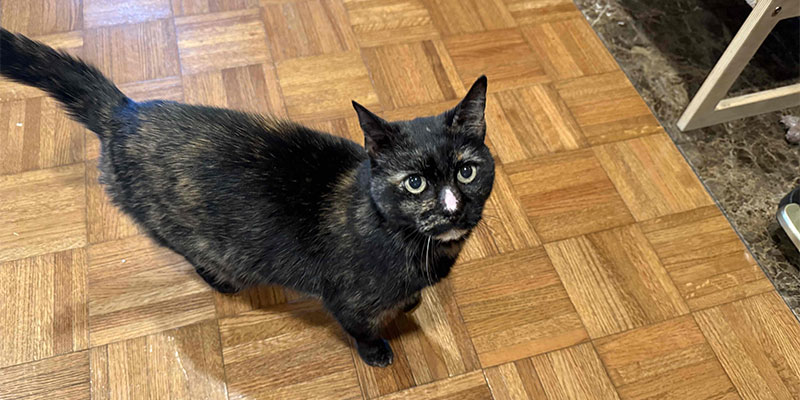
We have snow! Only an inch or so, but still snow. The animals are horrified and excited. We got the semi-feral cat inside, and she is being very persistent about getting pets. If only she didn’t go to war any time she sees the other cats, we would be in business.
So far the grid is holding.
We also have a fire. If you are getting this through email, there is a video of the fireplace here.
Kid 1 asked why it was this funky yellow color. It’s that color because iPhone attempts to enhance colors. Look at this yarn I bought.
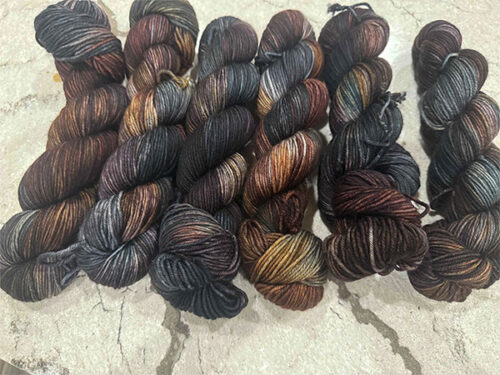
Pretty, right? I bought it because it looked like that in the picture.
This is what it actually looks like in person.
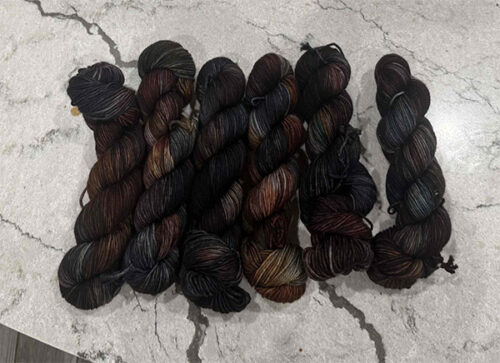
This shot was taken far away. I stood on a chair so I would get a wider angle and the iPhone color correction wouldn’t kick in on the yarn specifically. It was like magic: you hold the iPhone over it and look at all the colors. You can even see that the color of the island is different, more yellow, and there was no filter involved. I tried turning off HDR and all that, but the color correction is still happening.
I’m not a fan of that brown. Just no. I’m not going to return it. It’s a small business dyer. Their overhead is already low and shipping yarn back and forth is silly. When you buy small batch dyed yarn, there is a chance for stuff like this happening, so I decided to dye over it. I wanted to experiment anyway so we will see what happens.
On that note, Expression Fiber Arts has yarn kits at 17% off today, according to their newsletter. Not today, Satan. Not today. I do not need pretty yarn kits. I need to finish my happy cardigan. I need to find some white worsted weight yarn for the trim somewhere. For some reason I only have off-white. Also I need to work! Yeah.
Yesterday we plotted the next scene and I ended up measuring the living room with measuring tape to figure out how big of a hollow we need.
The depression gouged the forest floor, about forty feet long, twenty-five feet wide, and two feet deep. It was less of a pit and more of a hollow, vaguely rectangular, but without defined corners or sheer walls that pointed at a human with a shovel being involved. The edges of the hollow sloped slightly, as if some giant pressed their palm into soft sand, and the ground at its bottom was bare and soft, like it had been plowed.
I’m going to make a big old pot of stew for today. I have mushrooms and parsnips I need to use up. Get stew cooking and then work. Maybe I will bake it. That way I won’t have to keep checking it on the stove.
Hold, grid, hold. Must make words happen.
The post Snow on Tuesday first appeared on ILONA ANDREWS.
Teaser Tuesdays - Wizard of the Pigeons
This is a reread. First time reading it has to be between 2001 and 2009 somewhere. I borrowed it and now finally have my own copy.I mostly remember atmosphere, vibes, and that I loved it. Starts out promising, the writing is so good!

He swallowed queasily. The footlocker seemed to swell to fill his room, muttering its ugly secrets to itself.
(page 35, Wizard of the Pigeons by Megan Lindholm/Robin Hobb)
---------
Teaser Tuesdays is a weekly bookish meme, previously hosted by MizB of Should Be Reading. Anyone can play along! Just do the following: - Grab your current read - Open to a random page - Share two (2) “teaser” sentences from somewhere on that page BE CAREFUL NOT TO INCLUDE SPOILERS! (make sure that what you share doesn’t give too much away! You don’t want to ruin the book for others!) - Share the title & author, too, so that other TT participants can add the book to their TBR Lists if they like your teasers!
Savage Sword of Conan is Back
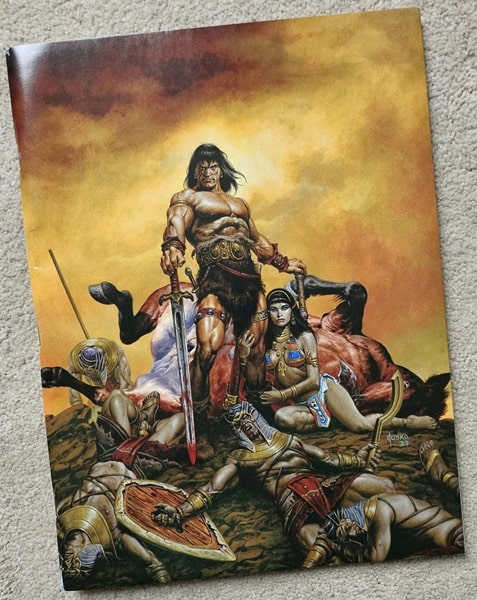
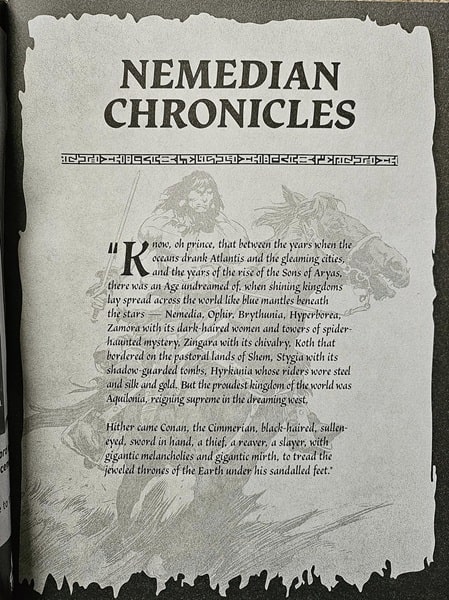
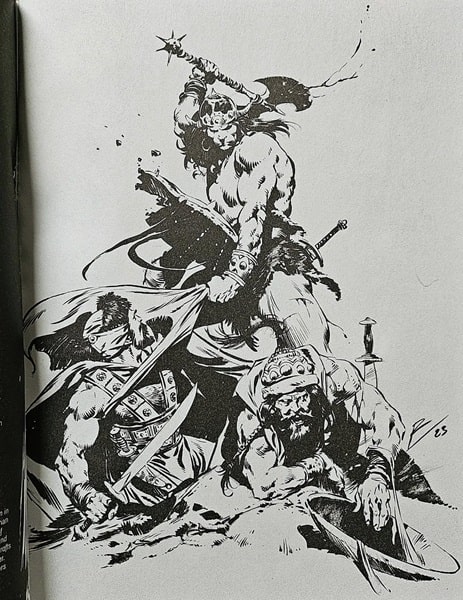
Savage Sword of Conan #1 (Titan Comics, February 2024). Cover art by Joe Jusko
Savage Sword of Conan, from Titan Comics, is the comic book that I have been waiting for. It is a thing of perfection: art, story, presentation, physical format – all unmatched.
The cover by Joe Jusko is brilliant, capturing some brutal imagery from the prose story within, penned by Jim Zub. I loved Joe’s work on the original SSoC run.
The introduction by Roy Thomas was a delight. Roy was the mastermind behind Conan the Barbarian and Savage Sword of Conan, but he’s also known for creating characters such as Wolverine, Vision, Werewolf by Night, Luke Cage, Iron Fist, Ultron, and scores more. Hearing that he had plans to contribute to this magazine filled me with joy.
[Click the images for savage-sized versions.]
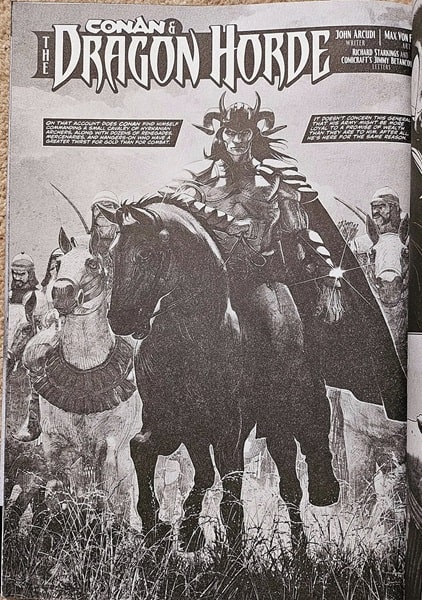
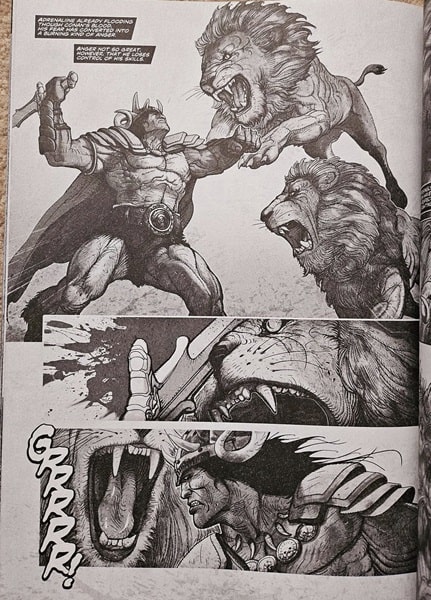
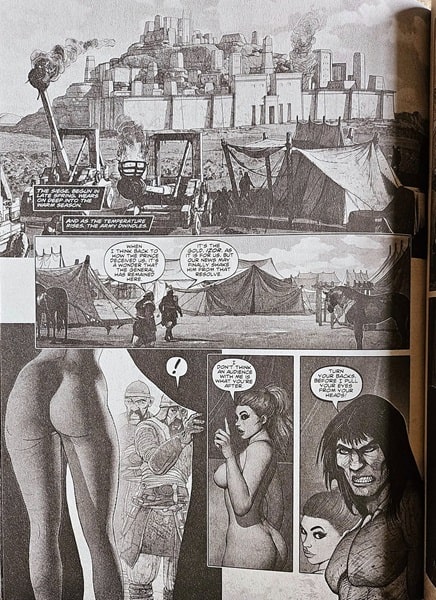
Interior pages from Savage Sword of Conan #1. Art by Max Von Fafner
The first story in SSoC #1 is called “Conan and the Dragon Horde,” written by John Arcudi, with art by Max Von Fafner. It has violence, bloodshed, nudity, sex, murder, betrayal, greed, superstition, intrigue, and horror. It is a classic Conan yarn that includes a fascinating female protagonist. Maybe she’ll stick around, or maybe she’ll go her own way, like Valeria. I can’t wait to see.
The prose story by Jim Zub, “Sacrifice in the Sand,” was a pleasant surprise. I have to admit to almost always feeling a sense of dread when someone other than REH writes Conan, but by Crom, this Zub guy gets it, much like his contemporary, John C. Hocking. The story was short, but the action was intense, realistic, and engaging, with a nice little twist at the end. Congrats, JZ.
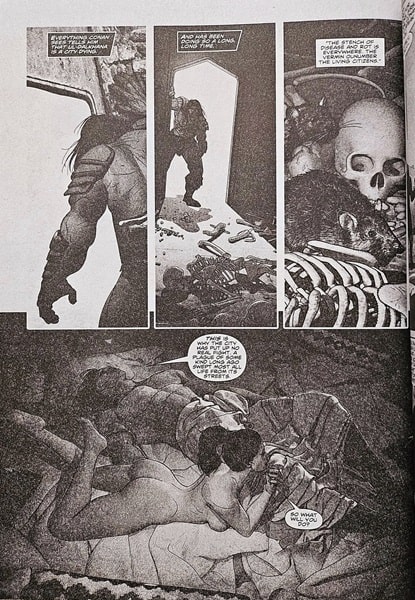
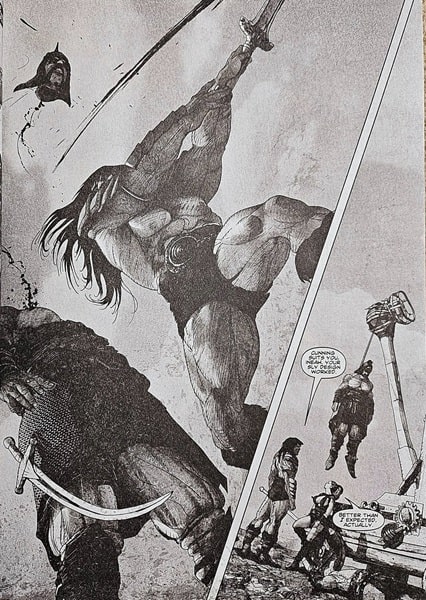
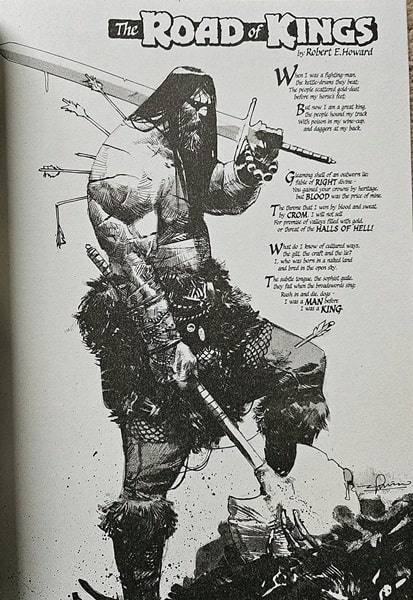
More interiors from Savage Sword of Conan #1. Art by Max Von Fafner
Next, we had a Solomon Kane yarn, “Master of the Hunt.” Placing an SK backup story in SSoC is chef’s kiss perfect. It brings back wonderful memories. Written and illustrated by Patrick Zircher, this was an excellent Gothic tale, with all that 1600s mood and tone. The Puritan gun-toting swashbuckler is one of REH’s finest creations, and he is well represented here.
The magazine closes with a piece by Jeffrey Shanks, who delves into the publishing history of Solomon Kane, which many readers will no doubt find fascinating. Jeff is a bona-fide REH scholar, much like my dog brothers, Mark Finn and Chris Gruber.
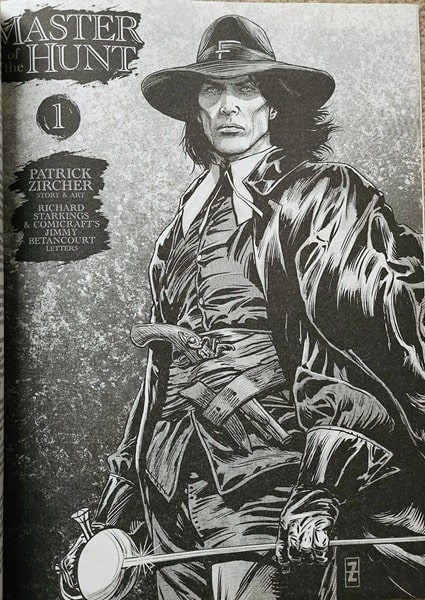
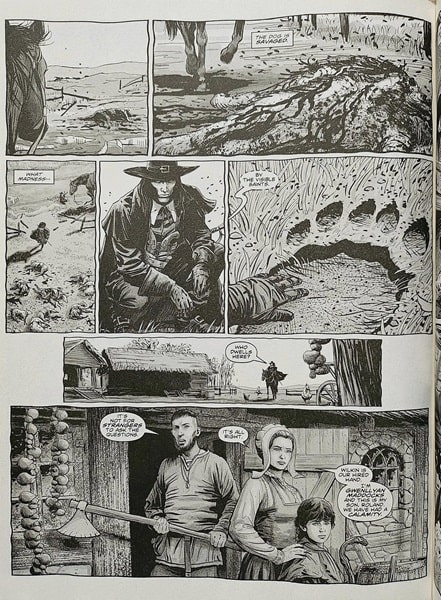
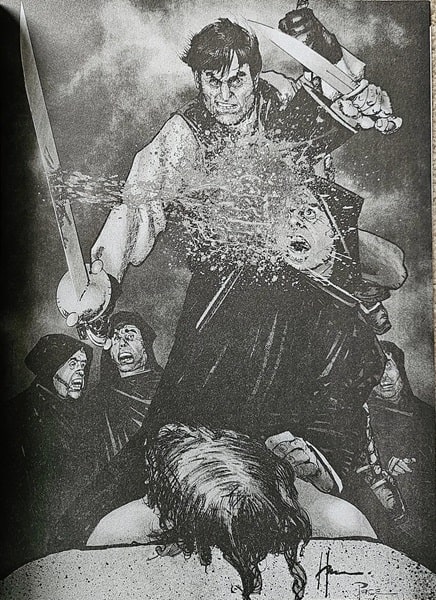
Interiors from Savage Sword of Conan #1. Art by Patrick Zircher and Howard Chaykin
This book was great. The husky offset paper is thick and opaque, yet has that newspaper quality to it, bringing back the nostalgia of the original run. You can smell the ink – it’s glorious.
One thing I would love to see in the future (and I know this is wishful thinking) is art by Val Semeiks in the pages of this series. I’ve been working with Val off and on for eight years on Hyperborea RPG content, and I think it would be a wonderful “full circle” event to see him back where he started – illustrating Kull in SSoC. I’d love to see that happen.
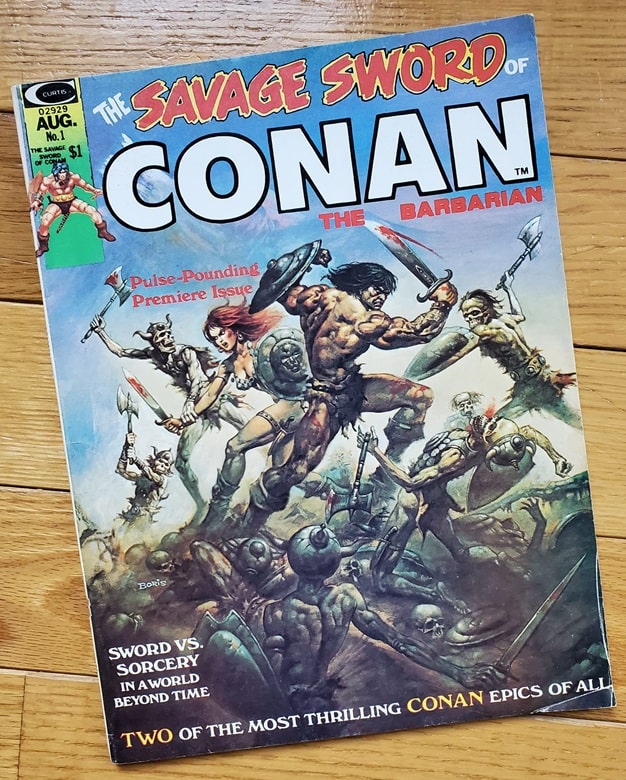
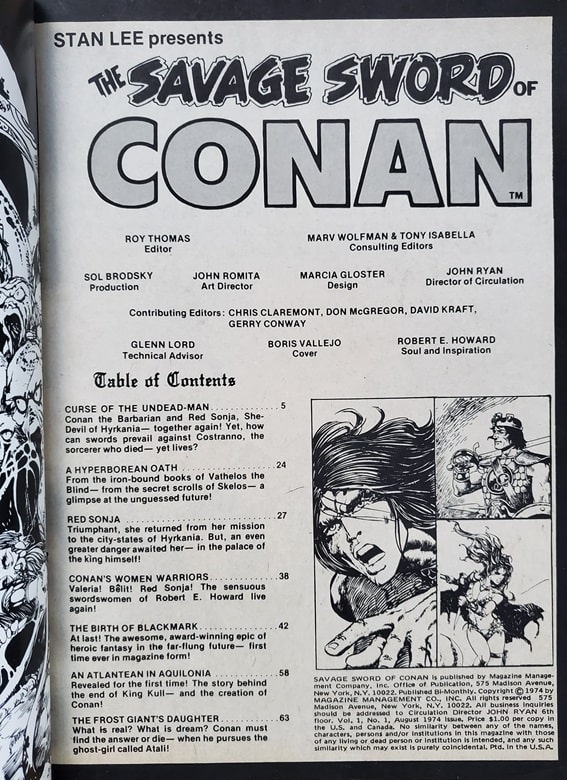
Savage Sword of Conan #1 (Marvel Comics, 1974). Cover by Boris Vallejo
The original Savage Sword of Conan #1 was published in 1974, featuring an incredible cover painting by Boris Vallejo (see above). It picked up where Savage Tales had left off, with Roy Thomas spearheading the efforts within.
The talent of the contributors is off the charts: John Buscema, Barry Smith, Alfredo Alcala, Gil Kane, Pablo Marcos, Esteban Maroto, Neal Adams, Ernie Chan, and a riveting article by Glenn Lord. All of it, as Roy Thomas states “… is dedicated to Conan and the other heroic-fantasy creations of the late Robert E. Howard (1906-1936).”
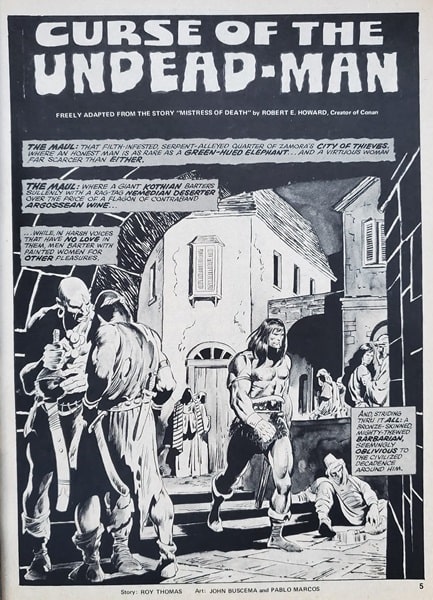
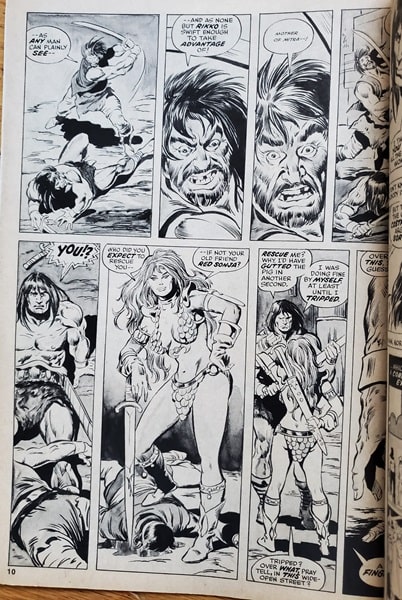
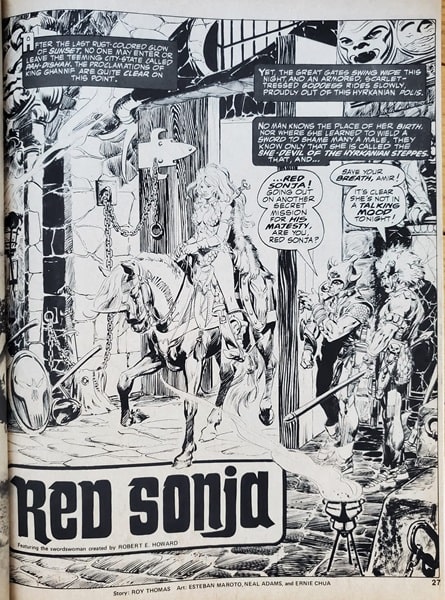
Interiors from Savage Sword of Conan #1 (Marvel Comics, 1974). Art by
John Buscema, Pablo Marcos, Esteban Maroto, Neal Adams, and John Chua
I already had a copy of this book, but I picked up this backup copy for $20 from my old pal, Chris, of Chris’s Comics.
For me, the most iconic Conan art was established by Frank Frazetta with his cover paintings on the Lancer paperbacks, and John Buscema with his cover and interior art in Marvel’s Conan the Barbarian and Savage Sword of Conan. When I was young, one of the things I always looked forward to was the next issue’s cover painting for SSoC.
 Cover art for The Savage Sword of Conan #54 (Marvel Comics, July 1980). Art by Earl Norem
Cover art for The Savage Sword of Conan #54 (Marvel Comics, July 1980). Art by Earl Norem
They rarely disappointed. Among those cover painting artists, one of my personal favorites was Earl Norem. I don’t believe he has received the attention he deserves for capturing incredibly dynamic scenes, such as the one pictured above, fighting a sand demon.
One of the prizes of my personal collection is the page below, purchased at a NY Comicon in the late 90s. This is an original page from Savage Sword of Conan #197, published in May, 1992.
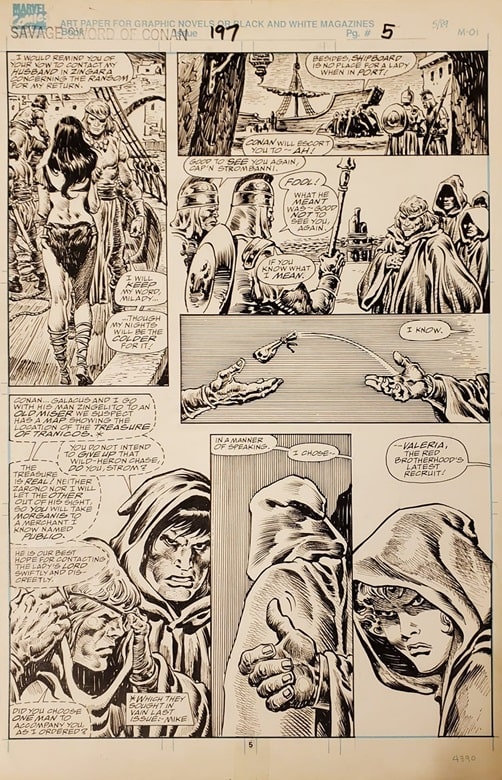 Original art from Savage Sword of Conan (Marvel Comics, May, 1992). Art by John Buscema and Ernie Chan
Original art from Savage Sword of Conan (Marvel Comics, May, 1992). Art by John Buscema and Ernie Chan
It features Roy Thomas writing, John Buscema pencils, and Ernie Chan inks. The ultimate creative dream team. On this page we see Conan, Belit, and Valeria. This is a one-of-a-kind piece that I will never part with!
One of the ultimate dream teams in comic book history was Roy Thomas, John Buscema, and Alfredo Alcala. The page below is from Savage Sword of Conan #20, adapting the Robert E. Howard story “The Slithering Shadow,” originally published in Weird Tales magazine in 1933. A sword-and-sorcery masterpiece.
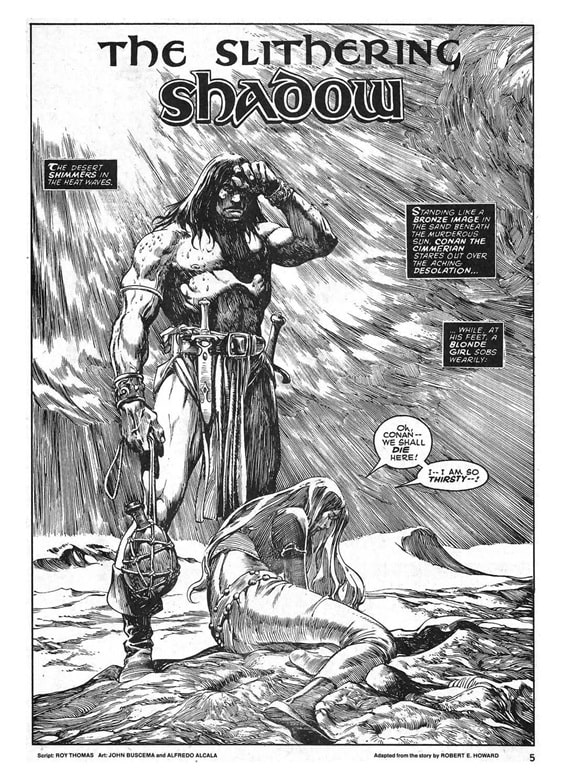 Splash page from Savage Sword of Conan #20, by Roy Thomas, John Buscema, and Alfredo Alcala (Marvel Comics, July, 1977)
Splash page from Savage Sword of Conan #20, by Roy Thomas, John Buscema, and Alfredo Alcala (Marvel Comics, July, 1977)
The third and final volume of Barbarian Life: A Literary Biography of Conan the Barbarian, by Roy Thomas, is a must-have for fans of Roy’s take on Robert E. Howard’s most famous character.
In thousands of four-color panels for Marvel Comics, Roy Thomas told the tale of Robert E. Howard’s greatest creation, Conan the Barbarian. Now, in this definitive biography and analysis, Roy chronicles Conan’s comic book life, issue by issue, plot by plot, and artist by artist.
For ten years, from October 1970 when Roy and artist Barry Smith assembled the first issue of Marvel’s Conan the Barbarian, to October 1980 when Roy and artist John Buscema completed their last issue together on the series, Thomas wrote of Conan’s gigantic melancholies and gigantic mirth — as well as the wars, the wenches, and the wizardry that bedeviled the Cimmerian from one issue to the next.
In this final volume of the series, Roy Thomas explains the creative process behind his final few issues of Conan the Barbarian, his run on King Conan, and selected stories published in Savage Sword of Conan. Additional features include a full-length interview with Roy, a short history of sword-and-sorcery in the comics, and the tale of Conan’s battles with the Comics Code.
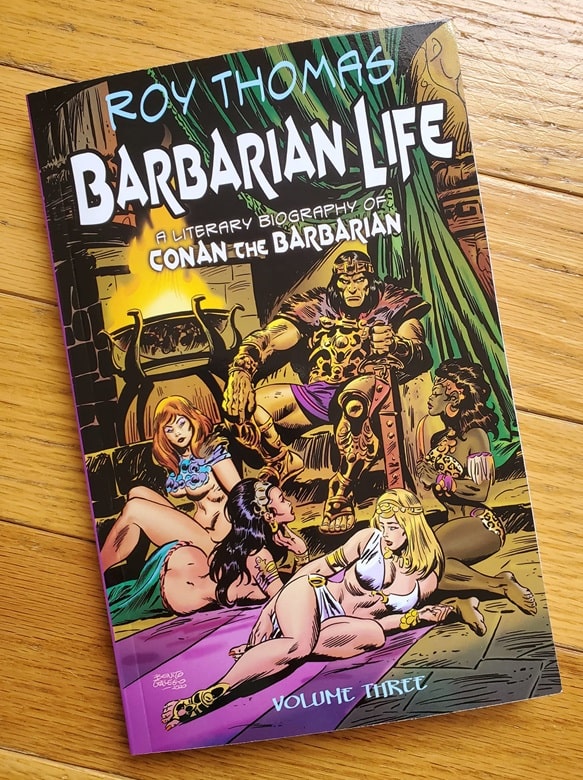 Barbarian Life: Volume Three: A Literary Biography of Conan the Barbarian by Roy Thomas (Pulp Hero Press, April 26, 2021)
Barbarian Life: Volume Three: A Literary Biography of Conan the Barbarian by Roy Thomas (Pulp Hero Press, April 26, 2021)
Now, I do want to preface what I am about to say by noting that my thoughts may be clouded by the nostalgia of my youth: lying on my bedroom floor, poring over my Conan comics and studying the words and art with rapt interest.
That being said, of all the pastiche authors who have developed new, original Conan tales, Roy Thomas may be my favorite — and he did it with the accompaniment of a brilliant visual medium, working with some of the finest artists of the day, such as the aforementioned Barry Smith and John Buscema, and also greats such as Alfredo Alcala, Gil Kane, and Ernie Chan.
Unfortunately, one of my favorite Conan artists, the incredible Val Semeiks, didn’t cross paths with Roy, but he deserves mentioning nonetheless for his breathtaking art.
Jeffrey P. Talanian’s last article for Black Gate was The Dreams in Gary’s Basement: Gary Gygax and the Creation of Dungeons & Dragons. He is the creator and publisher of the Hyperborea sword-and-sorcery and weird science-fantasy RPG from North Wind Adventures. He was the co-author, with E. Gary Gygax, of the Castle Zagyg releases, including several Yggsburgh city supplements, Castle Zagyg: The East Mark Gazetteer, and Castle Zagyg: The Upper Works. Read Gabe Gybing’s interview with Jeffrey here, and follow his latest projects on Facebook and at www.hyperborea.tv.
SPFBO X Finalist - Gates of Hope by J.E. Hannaford

ABOUT THE AUTHOR: J E Hannaford is powered by coffee, dragons and whisky. She teaches Biology in the real world and invents fantasy beasts to populate her own.
She lives in Suffolk, UK, and pines for the coast and mountains of Wales.
A love of nature and the ocean washes through the pages of J E Hannaford's stories and pours out of the characters who live in it.
Find J.E. online: website
Gates of Hope links: Amazon, Goodreads
ESMAY
Well, I don’t know what I was expecting from Gates of Hope, but I am pretty sure nothing could have prepared me for the wildly imaginative epic sci-fantasy adventure it turned out to be. It’s got dystopian landscapes and societies, completely unique flora and fauna, a magical academy and secret societies, at least six types of mystifying magic, planet hopping portals, and, hear me out, space dragons. What’s not to love… right?
From the very first page, I found J.E. Hannaford’s bold storytelling and rich prose to be incredibly immersive. Yes, we are dropped into quite a deep pool of unfamiliar fantasy terminology and complex history and lore, but the way that this entire world (or should I say universe?) unfolded through the three distinctly unique POV characters’ eyes felt wonderfully organic to me.
Whether it was Darin with his dream/song magic, dangerous secret society shenanigans, and newfound psychic moonhound bond (Star is the MVP!!), Suriin with her emotion magic and desperate lust for an adventure to take her outside the deep crater communities of Caldera, or the outcast Elissa all the way over on the moon of Tebein discovering outlawed magical powers that could save her entire race from the tyrannical rule of the alien awldrin overlords, if they don’t eliminate her first; I am not kidding when I say that every single chapter contained some type of new marvellous piece of revelatory world building that just filled me with awe.
However, as interesting and intriguing as I found the events unfolding throughout these characters’ increasingly wild lives, I have to admit that I never truly connected to any of them, and I soon found myself struggling to stay engaged by the almost slice-of-life storytelling. To me, Gates of Hope lacked a strong overarching conflict/plot pulling everything together into a cohesive whole, and it felt like everything was happening TO these characters rather than because they took any decision driven by personal motivations, which made it quite hard for me to really root for them.
Maybe I was just hoping and expecting this story to be something it was never meant to be, and ultimately I truly can’t deny that Hannaford’s ambitious vision for the Aulirean Cycle is beyond impressive. While this first book in the series failed to truly hook me at any point, I think the explosive ending showed a lot of potential and set up the sequel(s) in a very strong way. So, if you are looking for an exceptionally slow-burn and character-driven epic sci-fantasy adventure that is simply bursting with imagination, emotion, and heart, then I can’t recommend Gates of Hope highly enough.
ŁUKASZ
Sometimes, a book feels like it’s going somewhere, only for you to realize you’ve been waiting for things to happen and they still haven't. Gates of Hope is one of those books. It’s clear J.E. Hannaford poured her heart into building this world (interplanetary dragons, magical moonhounds, and a system of magic fueled by emotions and music), but all that effort doesn’t quite translate into an engaging story.
The premise is solid: a war-torn world, magical gates destroyed by a dragon, and three protagonists dealing with the fallout. But rather than picking up speed, the plot crawls. Elissa struggles under alien rule on one of the moons, Darin bonds with his moonhound while learning magic, and Suriin works on controlling her powers. They all have potential, but their stories don’t really connect, and for most of the book, it feels like nothing significant happens.
The pacing is the main culprit. It’s practically at a standstill for long stretches. The book spends so much time on small, everyday details and repetitive scenes that the plot barely gets a chance to move. Even when things finally pick up near the end, it feels too little, too late.
The characters also didn’t do much to save the story. While there’s some charm - Darin’s moonhound, Star, is a highlight - the protagonists themselves feel flat. Their personal growth and struggles should’ve been the heart of the story, but instead, it’s like watching three separate, slightly dull movies that never quite come together.
That said, the world-building is impressive. You can tell Hannaford put a lot of thought into creating her universe, and for readers who love rich, detailed settings, this might hit the spot.
If you’re patient and enjoy slow, slice-of-life fantasy, Gates of Hope might work for you. Otherwise, it’s a bit of a slog - a lovingly crafted world where not enough actually happens.
OFFICIAL SPFBO RATING




Recent comments